#unfortunately it is one of those “Mediocre media where you obsess over how it could have been good” things TO ME
Explore tagged Tumblr posts
Text
the really wanting to watch unicorn gundam to really hating unicorn gundam pipeline
#unicorn gundam#gundam#posting#gf & I finished it today#<-i sat through a rewatch cause she wanted to check it out#and she goes “oh now i know why you were so reluctant to do this”#unfortunately it is one of those “Mediocre media where you obsess over how it could have been good” things TO ME#because it has a lot of fun ideas and some good robot designs#but its just ideologically bunk (me when i am idealist)
10 notes
·
View notes
Text
Game, set, and twat: Whether it’s Meghan or Naomi Osaka, Piers Morgan’s MailOnline-enabled bullying has a pattern...
... the mediocre hack’s mediocre hack hates women who don’t dance to his tune.
Mic Wright
11 hr ago
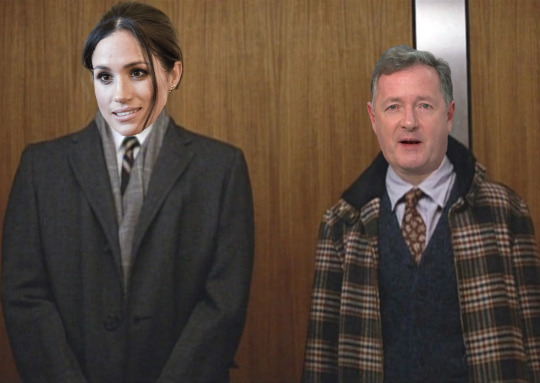
If someone had a blog and Twitter account where they relentlessly attacked a series of high profile women — many of them women of colour — for perceived slights and their refusal to pay the writer attention, we’d usually call that person a bully and a troll, and if they persisted in that behaviour they might even find themselves facing legal consequences.
But Piers Morgan has a TV career and a MailOnline byline so he’s given impunity to mock, abuse, and denigrate women while claiming he’s just a ‘critical voice’. His latest target is Naomi Osaka, the 23-year-old tennis player who is currently ranked number 2 in the world, is the reigning champion of the US Open and Australian Open, and became the first woman to win back-to-back grand slams since Serena Williams in 2015.
By contrast, Piers Morgan is a mediocre hack who owes his controversy-baiting career to Simon Cowell who pulled him out of the dumper of history and plonked him on the America’s Got Talent panel after he was frog-marched out of Fleet Street for slapping faked photos on the front page of a national newspaper. That incident was the last in an ignominious run at The Daily Mirror and, before that, in the Murdoch press, which I have covered extensively in the past.
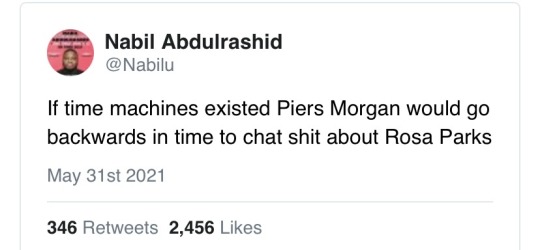
[image description] Twitter avatar for @Nabilu
Nabil Abdulrashid
@Nabilu
If time machines existed Piers Morgan would go backwards in time to chat shit about Rosa Parks
May 31st 2021
346 Retweets2,456 Likes]
Morgan’s latest creepy obsession was triggered — I use that word deliberately — by Osaka’s decision not to speak to the press during the French Open at Roland Garros because interviews were affecting her mental health. She subsequently withdrew from the tournament altogether after winning her first match, having been fined $15,000 for not speaking to the media and warned she was at risk of being expelled from the event.
In her statement yesterday, Osaka wrote that she had suffered “long bouts of depression” since she defeated Serena Williams in the 2018 US Open Final and received significant media attention. She continued:
I never wanted to be a distraction and I accept that my timing was not ideal and my message could have been clearer. More importantly, I would never trivialise mental health or use the term lightly.
Nothing in either of Osaka’s statements support Morgan’s sneering labelling of the player as “Narcissistic Naomi” or “world sport’s most petulant little madam”. Once again a 56-year-old man is using his vast and undeserved media platform to bully and harass a woman half his age. And — surprise, surprise — it’s actually just a new front in his obsessive one-sided war on the Duchess of Sussex.
Beneath the frankly unhinged headline, Narcissistic Naomi's cynical exploitation of mental health to silence the media is right from the Meghan and Harry playbook of wanting their press cake and eating it, Morgan writes:
Naomi Osaka is a brilliant tennis player…
… She is also the highest-paid female athlete in the world, raking in $55.2 million in the past 12 months, $5.2 million from tennis winnings and $50 million from endorsement deals with the likes of Nike, Beats by Dre, Mastercard and Nissin…
… Unfortunately, Ms Osaka is also an arrogant spoiled brat whose fame and fortune appears to have inflated her ego to gigantic proportions.
How else to explain her extraordinary decision to announce she will no longer participate in media press conferences, supposedly to protect her mental health?
Morgan is pretending that he doesn’t know that money is not an impregnable suit of armour to protect your mental health. Osaka could be the richest woman in the world and still face anxiety and depression. In fact, at just 23, the pressures of her performance-driven, endorsement-laden life are arguably more likely to lead to those feelings than a ‘normal’ one.
But rather than seeing Osaka as a young woman in an extraordinary position who is struggling with those demands and finding the hectoring, hostile, and entitled attitude of the press hard to handle at the moment, Morgan calls her “petulant” and continues:
[She] was fined $15,000 for refusing to appear in front of the media… Of course, given that she earns around $6,000 an hour, Osaka will recoup this fine while she sleeps tonight, rendering the fine utterly meaningless.
What's not meaningless is her frankly contemptible attempt to avoid legitimate media scrutiny by weaponizing mental health to justify her boycott.
Morgan departed Good Morning Britain after the row that followed his comment that he “didn’t believe a word” of the Duchess of Sussex’s statements about her mental health during the Oprah interview. Now, the mental health analyser has logged on again and he has determined that Naomi Osaka does not meet his standard of distress. Sadly, he secured his professional qualifications in this area by scrawling a certificate in crayon on the back of a Pizza Express kids menu.
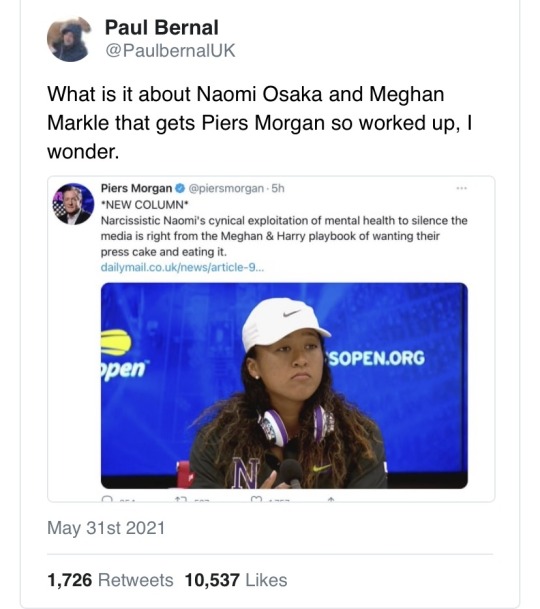
[image description] Twitter avatar for @PaulbernalUK
Paul Bernal
@PaulbernalUK
What is it about Naomi Osaka and Meghan Markle that gets Piers Morgan so worked up, I wonder. Image
May 31st 2021
1,726 Retweets10,537 Likes
-
He claims that after reading Osaka’s Instagram post about press conferences, which he calls “an orgy of narcissistic twaddle”, “several times” he experienced “mounting fury”. Remember, this is a 56-year-old man contorting his melted waxwork face into an angry rictus over a 23-year-old woman he doesn’t know choosing not to appear at a press conference. I am not convinced that Osaka is the narcissistic one here.
Morgan continues:
One thing’s very clear: This has got nothing to do with mental health.
What Osaka really means is that she doesn’t want to face the media if she hasn’t played well, because the beastly journalists might actually dare to criticise her performance…
… This is straight out of the Meghan and Harry playbook of wanting to have the world’s largest cake and eating it, by exploiting the media for ruthless self-promotion but using mental health to silence any media criticism.
One thing’s very clear: This has got nothing to do with Naomi Osaka.
What Morgan really means is that he’s still beetroot red over a perceived slight by Meghan back in 2016, which he only started ranting about after he didn’t get an invite to her wedding and was “ghosted”. That came after two years of him tweeting about her as a “friend”.


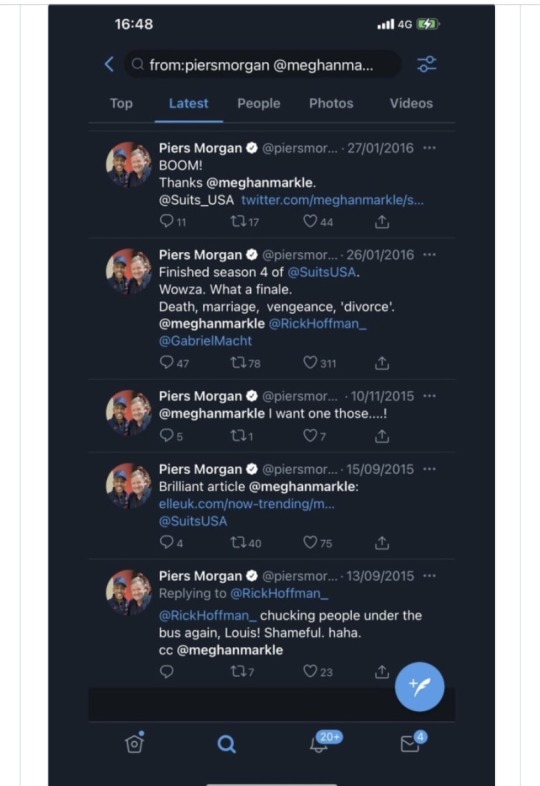
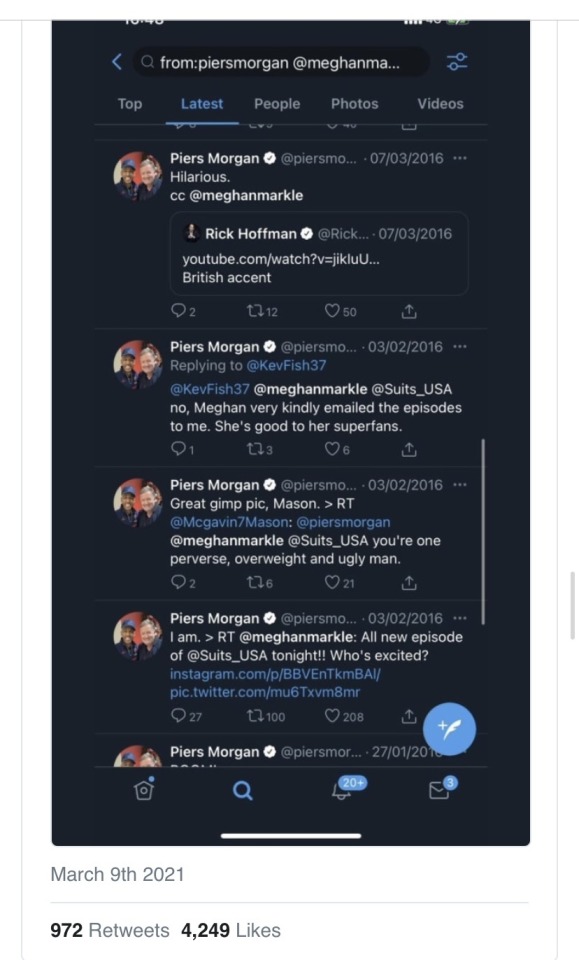
Piers Morgan is simply using Naomi Osaka as another way to wage his sad fuck guerilla war against the Sussexes. And Osaka is just the latest in a long string of young women to fall short of his weirdo expectations.
He berated Lady Gaga on social media, attacking her after she spoke about dealing with PTSD after being raped, and goaded her so much that she agreed to an interview clearly in the hope of getting him to stop.
He attacked Arianna Grande after the Manchester Arena attack and kept up his bullying for six months until she agreed to have dinner with him after what he said was a “chance meeting”. After she had conceded to spending time in his fetid presence he shifted tack and started creepily calling her his “soulmate” — she was 26 at the time.
These obsessions with young women are often framed as “feuds” in the press, but they are, in fact, byline-enabled stalking. Morgan has a huge platform and he abuses it to get women to concede to him, to make mollifying noises, to pretend that they are his friends just to get him to stop.
The only difference between Piers Morgan and a street harasser screaming at a woman to smile is that MailOnline and ITV pay him handsomely for the privilege. Tonight, Morgan’s ‘Life Stories’ interview with Keir Starmer goes out on ITV and he’ll once again get a chance to dominate the headlines. His views are given credence by the political elite even as he continues to abuse women for attention and praise.
It’s a tactic he’s used for decades, stretching back to his time on The Sun’s Bizarre column, where he insisted on inserting pictures of himself cuddling up to celebrities. His ‘feud’/obsession with Madonna has run on for decades, beginning in his Fleet Street days when she didn’t give him the exclusive on her first pregnancy and continuing right up until now.
As with Lady Gaga, Morgan has repeatedly mocked and dismissed Madonna for saying she was raped in the past. However, unlike Gaga, Madonna has refused to pay homage to Morgan with an interview. He preemptively ‘banned’ her from his CNN show back in 2011 though she had shown not one scintilla of interest in appearing, and tried to reignite interest in his hatred for her in 2016 by saying he would end “the feud” if she apologised to him. He’s still waiting for that call.
Morgan’s attack on Osaka, which is simply another attempt to get at Meghan, came two days after a Daily Mail interview with Jan Moir in which he grumbled:
[Meghan] thinks she’s beaten me? She might be in for a surprise because I suspect I’ll be back soon. If Meghan thinks she has cancelled me or won the battle, she is in for a big shock. I’ve never been more popular.
It made me think of this moment in Mad Men:
Michael Ginsberg: What do I care? I got a million of them… a million…
Don Draper: Good. I guess I’m lucky you work for me.
Michael Ginsberg: I feel bad for you.
Don Draper: I don’t think about you at all.
Meghan is Draper. Morgan is a total Ginsberg — smug and self-satisfied, convinced that Meghan is as obsessed with him as he is with her, certain that they are having a feud between equals and not the same dynamic as every woman cursed with a sad but sinister stalker.
And while Morgan acts like he’s a brave truth-teller, he only dares pump his horseshit opinions into MailOnline’s open sewer once he’s fairly sure that there are enough other media bullies taking the same line. The Australian’s tennis correspondent Will Swanton filed his misogynist screed a full day before Morgan got round to his.
There’s a clue as to how Morgan expects young women to act around him in the latest instalment of his journals — The Diary of Samuel Creeps — which are published in The Mail on Sunday.
Recounting his visit to what sounds like a truly mind-numbing party (“…drinking cocktails, nibbling canapés and having actual ‘fun’ in the garden of the Notting Hill home of Gabriela Peacock, nutritionist to the stars.”) he describes an encounter with Princesses Beatrice and Eugenie:
Princess Beatrice arrived with her husband Eduardo. They announced her first pregnancy today, and both seemed ecstatically happy.
‘Please thank your mum for her supportive texts when I left GMB,’ I told her. ‘She’s always been very loyal to me, and I greatly appreciate it.’
‘Well, you’ve been very loyal to her,’ Beatrice replied, ‘and she appreciates that too.’
I’ve always had a soft spot for Fergie.
Princess Eugenie, who gave birth to her first child three months ago, joined her sister. ‘If you two need any parenting tips for your expanding Royal creche, I’ve had four kids so am something of an expert,’ I suggested.
Their regal eyebrows shot up in synchronised horror. ‘No, we’re good thanks, Piers,’ came the firm, unified response.
I’ve known both Princesses since they were very young, and they’ve been through a lot of tough times in the media spotlight, especially lately over their father Prince Andrew’s shameful friendship with billionaire paedophile Jeffrey Epstein.
But they never complain, or give whining interviews, or publicly trash their family, and they’re always incredibly nice, polite and good fun – which all makes such a refreshing change from their narcissistic, self-pitying, family-abusing, spoiled-brat cousins over in California.
Piers Morgan wants to be treated as famous rather than infamous, and likes women to indulge his antics and act as if they’re amused by his sweaty-handed attention. Fergie — a woman devoid of discernible talent beyond tolerating her ex-husband’s second career as the top Yelp! reviewer at Jeffrey Epstein’s houses — is a-ok with Piers because she sucks up to him. Similarly, her daughters are delightful because they’ll tolerate Morgan’s dad jokes and fetid familiarity.
Morgan is not a journalist, a truth-teller, a maverick, or a commentator in anything but bad faith. He’s nothing more than a misogynist with a MailOnline byline and some big money contracts. Don’t let him pretend to be anything else.
13 notes
·
View notes
Text
Peach (Lobotomy) - Part One

Pairing: Hoseok x Female Reader
Word Count: 4.6k
Rating: G
Genres: SFW, Soulmate AU, College AU, F2L, Angst, Fluff
Summary: In a world where there is no limit to the number of possible soulmate connections, you've become obsessed with figuring out what yours will be. While walking to class one day, you find a ring on the ground. A ring that will finally lead you to your soulmate.
Warnings: this is only part one! this is slightly angsty, but there is fluff.
A/N: Proud to be part of the Luv Library Collab! This is the first part of my first soulmate fic. Part two will be coming before the end of the month. I may also do a NSFW one shot later this year. I’m excited to continue working on my soulmate series (one for each member). They are all based on songs by Waterparks, check out Peach (Lobotomy). Big shout out to @megahwn and @joonkookiemonster for beta reading, @namluve for this beautiful banner, and to @ho-baebae and @lovely-literati for always being supportive. Love y’all! 💜
~~~~~~~
You've seen it happen a million times before. When someone meets their soulmate for the first time, it’s like watching magic happen. It's just a moment, a spark, and then that person's entire life changes.
There are countless types of soulmate connections out there. From color blindness and red threads to timers and birthmarks. Some people can write to their soulmate and the words will appear on their skin, no matter how far away they are. Some people can hear the thoughts of their soulmate or taste what they're tasting. It's exciting, waiting to meet that person who is everything you need. The person made just for you.
But it's terrifying for those who don't have an obvious connection to their soulmate. It's terrifying for people like you. You weren't born with a special mark, you weren't born with colorblindness or someone else's thoughts in your head. There's no obvious way for you to connect with and find your soulmate, and it often keeps you up at night worrying.
Being the optimistic person and hopeless romantic that you are, you've done your best to stay positive. You know that there is someone out there, there's someone for everyone. So you've spent the first 21 years of your life keeping your eyes wide open. Waiting for the sign, the connection.
When you were in high school, you were sure that your connection must be eye contact. You walked around constantly looking people in the eyes, probably looking like a psychopath
The summer before college, you spent the summer abroad in Spain. Part of you hoped you would meet some rugged Spaniard, but the other part of you knew that your Spanish was mediocre at best.
Freshman year of college you had a persistent craving for pickles and you were sure that had something to do with finding your soulmate. But then you met Hoseok and he helped you figure out that you were just dehydrated and you needed electrolytes.
You actually met Hoseok in line at the dining hall. Your request for an entire bowl of pickles on the side disgusted him. He followed you to a table, confronting you about your strange eating habits.
“An entire bowl of pickles? That’s disgusting.” Hoseok joked.
“Well I’ve been craving them non-stop. Hopefully this is my soulmate connection.” You replied as you sat at the last open table, trying to avoid touching the various sticky spots on the table.
“You hope? As you don’t know what your soulmate connection is?” Hoseok questioned, mouth full of french fries.
“No, not for sure. I don’t have a mark or anything.” And as if he could sense your dejectedness, he cheerily followed up by telling you that he doesn’t have an obvious connection either. Of course your mind immediately goes to the possibility that he is, in fact, your soulmate.
It doesn’t help that he is gorgeous. Dark hair, chiseled jaw, bright smile hidden behind soft lips. Lips that you really really want to kiss.
Unfortunately Hoseok isn’t your soulmate. The two of you spent almost everyday together for the semester and no connection ever presented itself. Eventually the urge to kiss him dissipated (for the most part) and you gained a really great friend. Every time you feel miserably alone, he’s there to comfort you. He's been there for every missed connection, every failed attempt to find your soulmate.
There are still days that you wake up with The Feeling. The feeling that tells you it’s finally the day you’ll find your soulmate. And today just so happens to be one of those days. When you woke up, you didn't feel tired. You were able to get up and out of bed and ready for class in time to stop to get coffee for you and Hoseok.
The Feeling leaves you on edge. You keep your phone in your pocket instead of scrolling through your daily rotation of socials. Making sure to keep a small smile on your lips, you try to make eye contact with as many people as you can.
Surely people think you are a crazy person, but you won't miss an opportunity to meet your soulmate for the first time. Unfortunately, none of the customers in the coffee shop or the Baristas are your soulmates. But that's okay! There is still plenty of time left in the day.
"Today's the day Hobi! I can feel it." Hoseok is leaning up against his car in the parking lot waiting for you as usual. The two of you have the same math class every Monday, Wednesday, and Friday morning.
"Yeah I'm pretty sure you said that about last Wednesday too." Hoseok playfully nudges you as he accepts the coffee you've brought for him.
"Okay yes, but I feel REALLY good about today. Maybe I've just been missing him by a few minutes."
"I wish you weren't so obsessed with this, Y/N." Hoseok pauses, adjusting the strap of his backpack. "You always end up disappointed and I hate seeing you upset."
"Wow thanks for believing in me." You turn away from him and continue down the sidewalk path, rapidly approaching the Mathematics Building.
"It's not that I don't believe in YOU, I just hate watching you obsess over this, can't you just enjoy life and let your soulmate come to you?"
"LET MY SOULMATE COME TO ME? Hoseok didn't you hear about the girl who WAITED for her soulmate to find her and ended up finding him in a COMA? I CAN'T RISK IT!"
"Y/N you can't assume the worst just becau..." And you don't hear the end of whatever Hoseok was going to say. Because in that moment you see something shiny on the ground a few feet in front of you.
You jog ahead of Hoseok, and you see a gold ring abandoned on the sidewalk. You bend to pick it up. Hoseok has now caught up with you. He's trying to get your attention, but all you can focus on in this moment is the ring. You have the same giddy feeling you always do. Butterflies flitting around in your stomach. It’s your soulmate's ring, you're sure of it.
"What is it Y/N?" Hoseok leans over your shoulder to see the ring you're turning over in your fingers. It's a fairly simple gold ring. There is a simple design carved around it and an inscription inside it. Two initials. You can feel your heart swell, your pulse begins to race.
"It's my soulmate's ring Hobi. I knew today was going to be a good day." You can read the skepticism in his frown and knitted brow. He doesn’t refute you though, maybe he can sense the certainty you’re feeling.
“We’re gonna be late for class.” He huffs, continuing down the path at a pace you struggle to keep up with.
~~~~~~~
The lecture on Inverse Trigonometric Functions does not hold your attention very long. All you can really do is turn the ring over in your fingers imagining the man that it belongs to. He’s probably got dark hair, tan skin, glasses. He probably looks so sexy in glasses.
“So I guess you’ll be borrowing my notes later then?” Hoseok whispers and motions toward your blank notebook. “Of course, you’ve got something more important to do than take notes, don’t you?”
“Yeah I’ve got to track down my soulmate.” As soon as you finish the thought, reality begins to sink in. “Hobi?” You whisper back at him, shoulders slumping. “How am I going to find him?”
Hoseok sighs, settles himself back into the seat, and continues taking notes. Absentmindedly, you pick up your pen and begin doodling the initials “JW”. Your pen traces over the letters, darkening them with each stroke.
“We’ll find him.” Hoseok places his hand over yours, stopping the obsessive movements of your pen. When he pulls his hand back you look up at him. He’s looking forward, jaw clenched. And you know that just like every other time, with every other potential soulmate, he’s determined to help you.
~~~~~~~
Hoseok asked you to sleep on it, give yourself some time to process before beginning the process of finding the owner of the ring.
It was a nice idea, sleeping on it. But in practice it proved to be very difficult. After tossing and turning for half an hour you began mentally designing a Found: Gold Ring flyer in your head and planned where to put them up around campus.
Now your mind has wandered elsewhere. You find yourself browsing social media, looking at the University’s page. Scrolling through the followers and stopping at every J and W you find.
You: I'm never going to find him. [4:12am]
You: Do you know how many JWs there are in this city? [4:12am]
You: And what if he's not even on social media? [4:16am]
Hoseok: Everyone is on social media. [4:18am]
You: Oh no did I wake you? [4:18am]
Hoseok: Yes. Please tell me you have not been awake all night. [4:18am]
You: I have not been awake all night. [4:19am]
You: 😬 [4:19am]
Hoseok: I have an idea. [4:20am]
You: 👀 [4:20am]
Hoseok: I have a friend who works as a student assistant in the registrar's office, maybe he can help us. Let's meet at 8 instead of 8:45 [4:23am]
You: okay 🥺 [4:24am]
~~~~~~~
"What do you mean "no," Namjoon?" Hoseok is standing at the front of Namjoon's desk.
"Hoseok I am not breaking FERPA for any reason." The blonde boy leans back in his chair, crossing his arms. Government policy prevents him from sharing student’s personal information, but this is bigger than the government. It’s fate, the Universe, call it what you want, but it’s more important than FERPA.
"Namjoon, I need to find my soulmate, I have to track him down!" You're about to start crying, peering around Hoseok. You had only seen Namjoon once before at a party, he was drunkenly debating the finer details of Platonism with a girl who was clearly only interested in taking him upstairs.
“If I were to give you a list of all the names and phone numbers of students that go to this University, I could be fined thousands of dollars!” He uncrosses his arms and hits his hand on the desk to emphasize his point.
That’s when you notice the timer on his wrist. Counting down to the moment he meets his soulmate.
“Namjoon, look at the timer on your wrist. You know exactly when you are going to meet your soulmate. But I have nothing.” He looks down at his wrist, the timer silently ticks closer to zero. “I have no timer, no mark, no connection except maybe this stupid ring.”
You tug at the ring you placed on a chain around your neck for safe keeping. It shines under the fluorescent lighting. Namjoon looks at the ring then back at your face. You’re sure it’s blotchy and red, but you hope that he understands how important this is.
“Can you help us Joon?” Hoseok asks, pulling a small flash drive from his coat pocket. The only response is a deep sigh, but Namjoon grabs the flash drive and quickly downloads the data.
“If anyone finds out about this, I’m going to say you hacked into my computer.” Namjoon says, stopping short of handing the drive back to Hoseok.
“I owe you one.” Hoseok winks before he grabs the drive out of Namjoon’s hand.
Hoseok heads out into the hallway and you follow closely behind him, turning back to mouth a ‘thank you’ at Namjoon who responds with a curt nod.
~~~~~~~
After a trip to the library and $25 worth of printing, the two of you are holed up in your apartment. Take-out, two bottles of wine, and 250 pages of student names and phone numbers are set out on the coffee table, an R&B album playing on the stereo. Hoseok watches as you flip through the large stack of pages on the coffee table.
“Wait why did you print every name?” Hoseok wonders while he picks at the remains of the food in his container.
“You said it would be easier to have a hard copy.” You huff, dropping the pages on the floor in front of you. Hoseok can feel the frustration radiating off of you.
“Yes, but maybe we should have sorted out the Js and Ws before printing...” He sets down his food and motions for you to hand him the pile.
Hoseok begins thumbing through the pages, wondering to himself how long it will take to narrow down the pool of potential soulmates. He locates the Ws and sets the rest of the pages aside.
“Here, let’s just start here and see what we can find.” He says, splitting the smaller stack in two and handing you half. Hoseok begins reading through each name on the page, pausing only to highlight a name or take a drink from his wine glass.
After about half an hour, Hoseok has highlighted two dozen names on his portion of the list. You're huddled over the pages, flicking the corners of it absent-midnedly. He can tell that you’ve lost steam, possibly from the two very full glasses of wine you’ve had tonight.
“Are you almost finished?” Hoseok sets his pages down on the floor next to him and leans his head back against the couch behind him.
“Oh yeah I finished, I just wanted to go back through to be sure.” You lean back from your hunched over position and lay flat against the floor.
“I’ve got about two dozen names, how many did you get?” Hoseok yawns and rubs his eyes.
“I found thirty.” You manage through a yawn of your own. It’s barely 9:00pm, but the mundane task of finding matching initials mixed with bellies full of take out and wine makes for a couple of very sleepy friends.
There’s got to be something he can do to reenergize the two of you. He knows you’re excited to find your soulmate. But after being by your side through so many failed attempts in the past few years, he can tell you’re starting to feel discouraged.
“Get up.” Hoseok says, an idea brewing in his mind. You look up at him, eyes narrowed. “Come on.” Hoseok gets up and moves to put himself toe to toe with you. He reaches into his pocket for his phone and scrolls through his playlist.
An upbeat song begins playing through the speakers and Hoseok extends his hands out to you. He can tell you’re fighting a grin and that makes his own smile double in size. You finally give in and grab hold of his hands. Hoseok quickly pulls you up off the ground and twirls you around before letting go.
“I’m not doing this Hobi.” You stand still, covering your face with your hands while the beat of the song fills up your small apartment. Hoseok’s body is moving to the music. He’s always been a dancer, effortlessly contorting his body, hitting each beat perfectly in time.
Hoseok knows you aren’t a good dancer, but he loves seeing you try. Loves watching you be silly. So he reaches for your hand once again and pulls you toward him. He uses his hands to guide you, gently shaking you to loosen up your joints. Your awkward movements make him laugh, but he’s happy to see you smiling again. Swaying along to the music with you, Hoseok feels good. The stress of the day melting away.
He twirls you away from his body as the song is ending, but instead of letting go he tugs on your arm, silently asking you to twirl back into his arms. You’re giggling when you fall back into his arms. His face is only inches away from yours and for the first time in a long time he finds himself wanting to close the distance.
When the two of you first met, he felt a pull to you. At first he had hoped that you were his soulmate. You were beautiful, funny, silly, and just what he had been looking for. There was no magic moment between you though. No signal that your connection to him was meant to be something more than friendship.
Before he can think too much about how your lips still look so soft, you pull away from him. Hoseok pauses to catch his breath, shaking his head to clear out the thoughts.
“Okay I do feel better.” You announce, moving to the kitchen to pop the second bottle of wine. Hoseok sits down on the couch, picking up his laptop. He logs onto Facebook, trying to occupy his mind by searching for the first guy on with the initials J W. “Alright, this is it.”
“What is it exactly?” Hoseok replies, distracted by a video of goats screaming to the tune of Taylor Swift’s latest single.
“We’re about to find my soulmate Hobi!” Your beaming smile is almost enough to quell the unsettled feeling growing in his gut.
“Right, right. Here goes nothing.” Hoseok types the name of the first guy on his list and begins scrolling through his available pictures. He is scrutinizing the stranger, his clothes, the way he poses for the pictures. Soulmate or not, is this guy really good enough for you?
“What should the game plan be?” You say, almost startling Hoseok. “Should we just do a quick round looking for the ring in the pictures?”
“Yes let’s do that, and then we can go back through if we don’t find the ring on anyone.” Hoseok nods moving to the next name on his list, silently hoping that he isn’t the one either.
~~~~~~~
It was very easy for you to get distracted looking at these potential soulmates. Of course, based on their social media profiles it was also pretty easy to rule some people out. Several of the men had their soulmate’s in the profile pictures. Some had visible soulmate marks or timers in their photos. But there were still a large number of men who could be the one. And you took your time sizing each one up.
Jason Williams is clearly athletic, plays for the university soccer team, and recently ran a marathon. It’s good for him, but you hope he won’t mind you sitting on the sidelines of the next marathon rather than participating.
Jaylen Williams has no photos available for viewing, but it only takes three seconds on his profile to realize that his views on feminism leave much to be desired.
Jesse Williams is a nerd, to put it lightly. His profile picture is a loveable picture of him dressed as Spiderman at last year’s comic con. Many of his posts are related to the Marvel Universe and you can tell that he takes it very seriously. According to his profile, he is studying physics.
Joshua Wilson seems nice. He’s playing guitar in his profile picture. His beanie and flannel shirt make you wonder if he considers himself a hipster. His latest post is about the inadequate coffee served at the local cafe and how he should just do it at home. Maybe he makes a good cup of coffee, you could get into that.
James Wilt is handsome. He’s hair smoothed perfectly back, facial hair trimmed neatly. Just as you’re about to scroll down to look at his posts, Hoseok interrupts you.
“Y/N?” He says quietly. “I think I’ve got him.” Your heart jumps into your throat. Setting the laptop down on the coffee table, you scoot over to look at Hoseok’s screen.
Jackson Wang. He’s gorgeous. And he’s clearly wearing the ring.
“Hobi...” You don’t really know what to say, but he seems to understand. He puts his arm around you and slides his laptop from his lap to yours. You begin scrolling through and seeing pictures of him surrounded by friends, they look like fraternity brothers. It’s not quite what you were expecting out of a soulmate, but as you continue looking through his profile you learn that you are actually quite compatible.
He has a similar taste in music, loves his family, he’s on the university fencing team, and he might love cheese even more than you do.
“I... I don’t want to be the one to say it, but all we know for sure is that it’s his ring.” Hoseok says sheepishly. You want to roll your eyes, but he’s right. Just because you had a feeling about it doesn't guarantee that Jackson is your soulmate.
“There’s only one way to find out.” You say handing Hoseok’s laptop back to him.
“Right.” Hoseok nods before tilting his head. “Wait what?”
“I’ll send him a friend request and I’m going to message him. I’ll have to meet him in person.” You say as you begin typing out a message on your computer.
“You are NOT going to meet him in person Y/N. He’s a total stranger!”
“Hoseok he could be my soulmate!” You pleaded. There’s a long silence stretching between you. Hoseok is thinking, scanning your face. He’s spent the day helping you track him down and now suddenly he’s so concerned about you meeting him?
“I’ll go with you.” He mutters followed by a sigh of defeat. He sinks back into the couch as you finish typing out your message to Jackson and attach an image of the ring.
You: Hey, are you missing your ring? I found one that looks like it outside the Mathematics building. [9:13pm]
“And now we wait.” You sigh as you hit the send button. The tension between you and Hoseok is still palpable, but you reach for the remote to turn on the television. Luckily for you, Hoseok’s favorite movie is playing on one of the channels and it doesn’t take long for the tension to relax into a comfortable silence.
~~~~~~~
Hoseok wakes to a ping on your phone. The two of you had fallen asleep on the couch during the movie. The TV screen is now dark, credits slowly rolling through. Your phone is shining brightly from it’s spot on the coffee table.
Against his better judgement, Hoseok reaches for your phone.
Facebook: Jackson Wang has accepted your friend request. [11:46pm]
Facebook Messenger: Yeah wow! I’ve been missing it! [11:48pm]
Hoseok sets your phone back down and looks over at you. You’re fast asleep, head resting on the arm of the couch. It’s getting late.
“Y/N.” He whispers, nudging your foot with his own. You don’t stir, so he decides to get up and carry you to your bed. He carefully pulls back the throw blanket that covers you and hooks his arms under your body. The walk to your bed is short, but he trips over a pair of your shoes, almost dropping you. How are you still asleep?
When he reaches your bed, he sets you down gently and pulls your quilt over your shoulders. He gazes down at you. Once again feeling the pull to your lips. He leans down, brushes a few stray hairs off of your forehead and lightly brushes his lips against the skin of your forehead.
A warm sensation, tingling in his lips, a shiver down his spine. Hoseok pulls away, wide eyes staring down at you. But you don’t wake up. Though he would swear that he saw a smile pulling at your lips as he slowly backed out of the room.
~~~~~~~
As you slept you dreamed about meeting your soulmate. The warm feeling radiated throughout your body, all was right in the world. And when you wake you are happy to see a response from Jackson.
Jackson: Yeah wow! I’ve been missing it! [11:48pm]
You: Okay, wanna grab coffee and I can give it to you then? [9:23am]
Jackson: Haha, sounds great. Maybe tomorrow around 10? [9:56am]
You: That’s perfect, you know The Bean just north of campus? [9:59am]
Jackson: Yes I love that place. [10:01am]
You: Okay great! [10:01am]
You: Kind of a random question... [10:17am]
Jackson: Shoot [10:23am]
You: Do you know what your soulmate connection is? [10:24am]
You: I’m only asking because I don’t know mine. [10:27am]
You: And I thought maybe... [10:27am]
Jackson: Do you think you finding my ring could be... our connection? [10:30am]
You: I had a really good feeling about it when I found it. [10:31am]
Jackson: I don’t know mine, so maybe this is it... [10:34am]
You: I guess we’ll find out tomorrow, right? [10:35am]
Jackson: It’s a date. [10:39am]
~~~~~~~
The Bean is bustling today. Lots of people in and out, dozens of students working on projects and papers, so Hoseok has to sit a few tables away from you. The smell of the freshly ground beans
“I won’t be able to hear you that well.” He shouts across the cafe.
You’re too nervous to respond with something other than a shrug of your shoulders. Fiddling with the hem of your dress, you watch the door carefully waiting for him to walk in. The latte in front of you is still steaming, too hot to drink.
The bell above the door chimes, ringing out over the chatter that fills the coffee shop. And there he is. Jackson Wang. Walking toward you with a self-assured smile.
“Hi.” You mumbled, standing from your seat to greet him. He’s glowing in front of you, he’s all you can see. Jackson opens his arms you fit perfectly in them. You can feel butterflies in your stomach. It’s not as strong as you expected the soulmate bond to be, but it’s there.
“I guess this is yours.” You tug lightly on the ring you’ve been wearing around your neck.
“Well maybe you should wear it for a little longer.” Jackson replies, motioning for you to have a seat. “If we’re soulmates, that is?”
“Did you feel it too?” You ask shyly, tucking your hair back behind your ear. Jackson nods and reaches out to grab your hand across the table. The Feeling is here, just like it was when you picked up the ring, and you never want it to go away.
~~~~~~~
Hoseok watches the two of you chat for over an hour. He sees the exaggerated reactions you give to whatever story Jackson’s telling you. Just by the way your face is lighting up, he can tell you’re already falling hard.
Thinking back to the night before, Hoseok questions what happened. Was it just the wine going to his head? The two of you had been friends for so long now that he assumed it couldn’t be possible that the two of you were soulmates. Surely any hidden connection you had would have been realized by now. Maybe he’s just feeling jealous that you’re finally meeting your soulmate and he’s still alone.
But that kiss was unlike anything he had ever felt before.
Deep in his thoughts, Hoseok doesn’t notice when you and Jackson stand from the table and walk over to his.
“Hobi, this is Jackson.” Hoseok jerks his head upward, met with a confident smile from Jackson. Hoseok quickly stands and extends his hand.
“I’m Hoseok, nice to meet you.” Jackson firmly shakes his hand. The two hold eye contact for just a little too long.
“She’s already told me so much about you. Thanks for helping her track me down.” Jackson chuckles. Hoseok looks over at you and notices that you are holding his other hand.
“Thanks for helping me find my soulmate.” You chirp happily. Hoseok narrows his eyes, looking back and forth between you and Jackson.
“Soulmates? Are you sure?” Hoseok questions you.
“Hoseok!” Your exclamation is accompanied by a slap on the arm. “Of course I’m sure!” You give a quick and embarrassed apology to Jackson.
The way you’re already clinging to Jackson makes Hoseok’s stomach twist. The look in your eye when you stare up at his face makes Hoseok want to shut his eyes. He can tell you’re smitten, but he’s got a bad feeling. Despite your obvious certainty that this is your soulmate, Hoseok can tell that something is just not right.
~~~~~~~
See you soon for Part 2! Comment to be added to the tag list! <3
Check out my Not Warriors Soulmate Series Masterlist!
#Luv Library#ficswithluv#fwl project#magicshopnet#bangtanhq#reader x hoseok#jung hoseok#bts#bts fan fic#bts soulmate au#hoseok soulmate au#hobi soulmate au#hobi#hobi x reader#jhope#jhope x reader#soulmate au#bts fluff#bts angst#hoseok fluff#hoseok angst#hobi fluff#hobi angst#jhope fluff#jhope angst#happy ending#hoseok college au#bts college au#hoseok f2l#hobi f2l
165 notes
·
View notes
Text
Before Sunset (Stony part 2)
“Stark never mentioned you.”
Steve immediately regretted his bluntness when he saw the shadow of hurt cross Peggy’s beleaguered eyes. Damn his lack of tact.
During Peggy’s final days, it was painfully obvious her condition was only worsening. It was apparent in her thinness, the sparseness of her whitened hair, the strain with every movement, and rarer lucid moments. Yet, as a testament to the strength she once exuded as The Agent Carter, she fought tooth and nail to last one more day--one more moment--for those she loved. Those, who weren’t ready to say goodbye.
Like Steve.
Of course he tried to be strong for Peggy, starting each visit with the decision of losing her, a life before the ice. At least, that’s how it would start. Instead, each visit ended with an unspoken plea for her to stay and, without fail, she would hear him. He knew he was being selfish, knew she was content with her own mortality, but...
Steve was just a man.
Not a super-soldier--damn being a super-soldier--but a man. And he was absolutely terrified of losing her, of what that could mean.
Steve gently grasped her hand, pulling it close to his chest as he leaned in from where he sat beside her hospital bed. Peggy was already smiling at him, soft and understanding, her reassurance cutting off his apology.
“It’s all right, Steve,” she said firmly. “I know you didn’t mean anything by it. In all honesty, I’m not that surprised.”
Steve brushed a light kiss over Peggy’s knuckles in gratitude, then rubbed little circles on the back of her hand with his thumb. Sensing she had more to say, he waited for her to continue. Her eyes flickered down to their joined hands, her smile turning sad with bitter edges. Closing her eyes as if to steel her nerve, she breathed a sigh before squarely meeting his gaze.
“After we lost you, Howard completely changed.”
Steve quietly listened as Peggy recounted Howard’s descent into alcoholism, fueled by the irrational belief that with Steve’s death went his only chance of ever creating anything good for the world. (“Stupid man,” she hissed.) The man tolerated living by existing down the neck of a bottle. Too stubborn to end his own life, Howard fashioned himself a new purpose: weapons manufacturing. Stark Industries became an empire of weaponry, built on Howard’s need to mask his weaknesses, to destroy any lingering vulnerability.
And with it, his humanity.
After years of obsessive entrepreneurship, wild philandering, and escalating alcoholism; Maria Carbonell entered Howard’s life and managed to stave his self-destruction by loving him. However, the reprieve was short-lived. When Maria gave birth to their son, Anthony, Howard recoiled in the face of fatherhood and retreated back to the comfort of Stark Industries.
And to the bottle.
Meanwhile, S.H.I.E.L.D. continued to contract Howard, willfully blind to his spiraling so long as he kept them stocked with state of the art weapons. Peggy maintained her close, albeit tumultuous, friendship with Howard and attempted to intervene when she could. It led her to form a surprisingly close friendship with Maria.
Peggy explained their friendship was gradual, starting with a dinner invitation after an impromptu visit to Stark estate on behalf of S.H.I.E.L.D. Both women bonded over shared interests and it steadily progressed to outings, like for tea and coffee, or to the park for little Anthony. Peggy admitted she quickly grew attached to Anthony, even volunteering to watch him when Howard and Maria traveled abroad, despite their available housestaff.
“He was such a sweet, sensitive child,” said Peggy, beaming at the memory, “very loving, but so quiet and so painfully shy. It took him some months to get used to me, but he did.”
“That’s hard to imagine,” Steve couldn’t hide his disbelief. The image of a shy little boy clashed with the hyperverbal and abrasive man he remembered from the invasion of New York.
Peggy eyed him reproachfully, effectively shutting him up.
“It’s true he’s changed much over the years, but I’m certain you can thank Howard for that.” She gave a derisive sniff.
“Anthony was beyond gifted and that kind of intellect would have felt like a curse,” she said matter of factly. “Children like that are branded as different--treated different--they start thinking they’re a mistake or unwanted. It’s even worse when that difference is punished by their own parent.”
Steve realized he could empathize with Stark.
Steve knew what it was like to be “different” from what society considered “normal.” He was born with a “different” body, near handicapped and unable to play with the other children. His head was filled with “different” thoughts, an attraction to men, a shameful secret too dangerous to reveal back then. “Different” was society’s polite way of saying “bad,” “unworthy,” and “unacceptable.”
A pang of guilt struck him for judging Stark.
Seeing Peggy’s stern face, Steve was reminded that she, too, could relate. He recalled their first meeting: Private Hodge’s crude, sexist remarks and Agent Carter’s fist meeting his face in righteous reply. Indeed, she was no stranger to being “different,” spending years judged or rejected solely for being a woman in a supposed man’s world. In the end, she persisted and made others respect her. Peggy never allowed herself to just “make do” with her differences, she embraced them, empowered by them.
She showed Steve what self-acceptance could look like.
Meeting Peggy had been the catalyst for Steve to begin accepting himself. Before Peggy, those back alley fights and military dreams were attempts to prove his worth, prove he can be good even if defective--a feeble nancy boy. He’d later realize his recklessness stemmed from a seed of self-loathing. It whispered, ‘I’m not good enough.’ After Peggy, he learned to tell himself, ‘I’m more than enough.’
Steve was torn from his musings when Peggy continued.
“Maria loved Anthony, unconditionally so. She tried to protect him from feeling apart from other children, but...” she paused, her hand tightening in his, “Howard was not so forgiving.”
As their friendship grew, Maria started confiding in Peggy about concerns for her family. How Howard held Anthony to such high expectations. How Howard too readily expressed his disappointment in Anthony. How Howard seemed threatened by Anthony’s budding genius.
Apparently, Howard was willing to go far to punish his son for his own shortcomings.
At three years old, Anthony’s IQ was tested and ranked well into genius level. Instead of pride, Howard justified the need to further distance himself from his son. He was convinced affection would only detract from the boy’s genius and cripple him with childish wants. He believed unnecessary attention would make the boy soft. So, if Anthony wanted acknowledgement from Howard, he would have to earn it.
And, oh, how the boy tried.
He tried everyday to earn his father’s love.
What little time father did spend with son consisted of condescending lectures and grueling projects. Each test a failure, in one way or another, according to the unachievable bar set by Howard, himself. At times, he would punish Anthony’s failures with vicious insults, other times with a heavy hand, but always with a stiff drink or two (or five) already in him.
At four years old, Anthony created his first circuit board. A big achievement for a little boy with hands too small to even nudge his father awake from a drunken stupor to appreciate it. At five years old, Anthony contracted chickenpox. His father forbade his mother from risking contamination by visiting the hospital. Their butler, Jarvis, was sent to check in on him as an afterthought. At six years old, Anthony found the courage to share his academic accolades with his father, like sacrificial offerings to appease a wrathful god. His father simply pushed past him to pour a drink, remarking on the ridiculous trend of schools celebrating mediocrity.
Steve swallowed hard as he forced himself to continue listening, his body drawn taut, but keeping his hands gentle around Peggy’s. Disgust gnawed at the pit of his stomach as he took in the information he was fed.
“What Maria was unable or unwilling to tell me, I learned from Anthony when he would stay with me. I felt so betrayed--not for myself, but-- for Maria and for Anthony. I confronted Howard, of course, and it was ugly.” Peggy’s voice began to rise in anger, her eyes flashing like dark clouds heralding a maelstrom.
“I couldn’t protect Anthony, not with Howard’s endless resources. He made sure I was kept away and any cage rattling I did was stilled, any court I appealed to was swayed by his money. ‘Silly complaints from a hysterical woman,’ they said. (She scoffed) S.H.I.E.L.D. was no better; one child’s safety was worth trading for a better arsenal. After a year or so, I learned Howard removed Anthony to boarding school and Maria was made to sever ties with me. I had no way of reaching out to him.
“After the accident, I had to stop myself from combing the media for news about Anthony. All the revolting things they’d smear about him, soulless cowards--it was destroying a part of me. I had to move on. But even though I lost Anthony, I still...I-I still...think a-about h-him.” She faltered.
With a sharp intake of breath, Peggy leaned back into the mountain of pillows stacked behind her. Closing her eyes, brows knitted, she grimaced as the brunt of the pain hit her. Steve knew it would be pointless to ask her if she was OK. Increased pain was par for the course, unfortunately. Freeing a hand, he gingerly rubbed her blanketed stomach and attempted to distract her.
“When I came back, I tried tracking down everyone from the war. I wanted to know who made it out, who got to live it out like we talked about in the trenches. I never would have guessed all of this about Howard,” he said, disillusionment laced with disappointment. “But, if you and Stark were so close before--I mean, even if Howard prevented you from seeing him, he would have remembered. He should have at least mentioned you, right?”
Steve recalled the S.H.I.E.L.D. reports issued to him when Loki stole the Tesseract, each a detailed profile on the Avengers. He knew his own profile was likely given to the others and would have included Project Rebirth, would have documented the involvement of one Agent Margaret “Peggy” Carter. Stark would have seen that, put two-and-two together, and...
He said nothing to Steve.
Granted, what Stark divulged or not was his choice and they were busy fighting a massive alien invasion at the time. Somehow, a part of Steve still felt unsatisfied by this. However, if he were honest with himself, their introductions were less than ideal, so really, would he have been open to a heart-to-heart with Stark then? Probably not. At least they parted on agreeable terms or he liked to think so.
Besides, reconnecting with the past has been Steve’s mission. Not Stark’s.
After tense moments of paced breathing, Peggy eventually relaxed. Opening her eyes to stare up at the bland ceiling, a noticeable shimmer glossed over her world weary eyes. A tear managed to glide down the many valleys of her face when she turned her head towards Steve, but she paid it no mind. The corners of her mouth curled, heavy with emotion and with a knowing that only the seasoned in life were privy to.
“What you are missing, Steve, is how tempting it is to run away from ourselves when all we know is pain. The deeper the pain, the further we run, especially when we think ourselves responsible, like all children often do. Genius or not, Anthony was no exception and even if he was, Howard made sure he thought everything was his fault. So, no, I’m not surprised he didn’t mention me. I’m forever tied to something much too painful.”
More tears chased a path down her cheeks, her next words gaining a depth of meaning.
“All we can do is our best and, sometimes, the best that we can do is to start over. I wanted that for Anthony and now, I want that for you, Steve. Live this new life and be happy. Forget the past, but remember to live today.”
#fanfiction#steve rogers#peggy carter#tony stark#howard stark#maria stark#memory sequence#been sitting unfinished forever#just wanted to get it out there#tired of staring at it in my saved files#unfinished Stony fic
7 notes
·
View notes
Text
How to Rise Above Marketing Mediocrity, According to Ann Handley
Ann Handley is a Wall Street Journal bestselling author, and has been named by IBM as one of the seven people shaping modern marketing.
She’s also the world’s first Chief Content Officer, and is a LinkedIn influencer with almost 400K followers. Needless to say, I was thrilled when she agreed to speak with me about the current and future trends in marketing at the 2019 Conex in Toronto. Along with marketing trends, we also talked about new approaches marketers can use to solve old problems. Because, while much has changed in marketing over the last few years, one thing remains consistent — businesses still need to connect with their audiences. Here, let’s explore Ann Handley’s take on pathological empathy, “snackable” content, and rising above marketing mediocrity.
Have Pathological Empathy For Your Consumer One of the key concepts Handley has pioneered is “pathological empathy.” Rather than simply segmenting customers by their behaviors or demographics and trying to appeal to them on those grounds, Handley wants marketers to get under their skin: “When I say pathological, I mean really understanding, sort of getting inside their skin … to get a sense of who are they and how can you best engage with them emotionally.” Ultimately, engaging with a consumer on an emotional level is one of the most sure-fire ways to guarantee a successful marketing campaign. (I dare you to watch Android’s “Friends Furever” video, the most-shared video ad of 2015, without tearing up.) This next-level empathy opens the door to a new approach to content creation. Handley poses the question this way — “How do we create the kind of marketing content, assets, campaigns that will actually touch their hearts … and maybe open their minds?” Slow Down In order to build pathological empathy, you need time. However, in a fast-paced marketing environment where everything moves at the speed of light, time is the most precious and limited commodity. Counterintuitively, this only proves Handley’s point:
“I’m on a mission to get marketers to slow down. Instead of approaching their job with an ‘as-soon-as-possible’ mindset, I think it’s much more valuable at certain key strategic moments to slow down.”
Handley says that by slowing down the marketing process at these strategic moments, marketers can better execute on building relationships and converting leads. “I think what we’re missing is that opportunity to say, ‘All right, what are the moments where we really need to think more strategically? Where should we slow down to fuel faster growth later?'” Speak to Your Audience as Peer-to-Peer, Not Brand-to-Target In addition to slowing down the marketing process at critical points, Handley suggests that marketers speak to their audiences from a peer-to-peer perspective, as opposed to brand-to-target. While marketers instinctively want to talk about what sets their brand and products apart, that’s not a message that can connect with customers. Handley told me, “We love our products and services and we understand on an implicit basis what value they bring to your customers or your prospects. But I think that we don’t always communicate that as effectively as we could. We’re not always leading with our hearts. We’re not always touching people in a way that will engage them emotionally.” Next time you’re constructing a web page or writing landing page copy, you might ask yourself — Would I, and my colleagues, like it designed this way? Would we keep reading? Would we click the link? Of course, you’ll want to A/B test and use focus groups to ensure you’re meeting your audience’s needs, but it doesn’t hurt to consider your own opinions and interests, or the opinions and interests of friends and family, when creating and promoting marketing materials. Be a Resource for Your Audience Handley told me marketers should be a resource to their prospects and offer them value. Part of this shift requires connecting with customers personally. You might try social media, but alternatively, consider putting a twist on an old marketing stand-by — the email newsletter. As Handley says, “Newsletters are vastly undervalued and they’re a huge opportunity that we’re not doing well.” Handley mentioned that, unfortunately, most marketers tend to focus on the “news” aspect of a newsletter, and forget the “letter” part of the equation. The “news” aspect means marketers use their newsletters as a distribution strategy and focus on providing updates about their own brand — but they fail to use the “letter” portion to engage with and connect to their audience. Handley notes that when writing newsletters, marketers tend to speak in the plural, but their audience is one person at home or on their phone. Handley says that by simply writing their newsletters as if they are talking to one person, marketers can go a long way toward building that personal connection. Handley says, “The person who was sitting on the other end of that email … It’s one person. They’re not sitting there with a thousand other people. So why do we communicate to a thousand people? That’s because we’re still thinking about it as news and not as a letter.” Don’t Create “Snackable” Content Video is another area where marketers are misreading the situation and losing out on chances to meaningfully connect with consumers. Handley pushes back on the notion of “snackable content,” and the idea that consumers are demanding it more.
“Our impulse as marketers has been to make it shorter and shorter and shorter to try to get people more involved. But from a consumer standpoint, I don’t think that that’s what our customers want.”
Rather, Handley thinks that this demand for shorter content was always there but never supplied. She told me, “I don’t think they want shorter and shorter and shorter. They don’t want lighter and more snackable … The way that we as consumers are consuming content has been to think about the value that it gives us.” Handley cites Netflix as a prime counterexample that disproves the idea that consumer attention spans are getting shorter, or that “snackable” content is king. “In a world of snackable, why does somebody sit down for hours at a time to watch the last season of Stranger Things? It’s because we want to — we want it on our terms, number one. But secondly, we have all the attention span in the world if it’s something that we care about.” Handley doesn’t think viewers’ attention spans are getting shorter or that they are seeking out shorter content. Instead, viewers are just more discerning about what content they consume. That suggests marketers shouldn’t shy away from longer video pieces, as long as these videos are about something that can connect with their target audience. Rise Above “Marketing Mediocrity” Businesses that fail to connect with customers fall into what Handley terms “marketing mediocrity.” Handley says it’s critical for businesses to rise above it. But how does a business know if their marketing is mediocre? “If people are not interested in you, if they are not here for you, if they are not thinking, ‘I can’t wait to see what they come out with next,’ then that’s a problem.” Handley says marketers should ask themselves what would happen if they went away. How would your email list react? Would any of your audience members write your team to ask where you went? Handley relates a personal story about her bi-weekly newsletter to drive the point home: “I usually mail Sunday mornings and I had a busy week … [s]o I didn’t mail until Sunday afternoon at four o’clock. And I got so many emails from people saying, are you okay? What happened? And so that to me was, it wasn’t just personally gratifying. [T]he big lesson there is … if you didn’t show up, would people say, ‘Hey, what happened?'” Do Less and Obsess In 2020, there are innumerable changes happening in the world of marketing. I asked Handley what her single most important piece of advice to marketers would be, and she told me, “do less and obsess.”
Handley suggests that marketers “do less and obsess” and focus on the fundamentals, and “create less with more intention.”
Handley also has some thoughts about content calendars. Handley suggests that marketers “do less that has more impact” rather than strictly abiding by a content calendar. “I think content calendars are amazing … I’m just saying, don’t let it run your strategy.” In the Future, a Customer’s Experience Will Dictate Your Strategy Finally, I asked Handley if she has any ideas on how we’ll be consuming content 10 years from now. While she thinks video is here to stay, she rejects the idea that the word is dead. “I hate binary choices like that. It’s not a matter of words or images. It’s both. To your question, what does this mean for us five years from now? think it’s a better integration and, and perhaps more interactivity.” Handley’s seemingly counterintuitive advice is based on marketing fundamentals, some of which today’s marketers might be forgetting as they become more enmeshed with new technologies. It’s easy to get caught up in current trends, but knowing your target audience and creating an experience they can truly enjoy remains the paramount goal of marketers. By taking a step back from today’s hot new marketing trend, we can get a better sense of how to use new technologies and strategies to deliver a valuable experience to our customers.
Source link
source https://www.kadobeclothing.store/how-to-rise-above-marketing-mediocrity-according-to-ann-handley/
0 notes
Text
Why You Need a Content Manager for Your Company (Some Tough Love from a Former Content Manager)
Let's cut to the chase. If you want to see results from inbound and content, someone in-house has to own your content as a full-time job.
Now, inevitably some of you are saying to yourselves:
"We're not ready to commit yet. We want to dabble first to see if inbound is for us."
You'll never get 110 percent results by putting in 50 percent (or less) effort. Success will only come if you commit fully. There is no in-between. (This is true for almost everything in life, so I'm not sure why anyone would think inbound would be different, but whatever.)
Or maybe you think you've got it covered:
"We've got a few people who can use part of their time on inbound, it's fine."
No. No, it's not fine.
You've got a few people who will deprioritize your content strategy the second something else "more important" comes along -- and you won't have anyone to hold them accountable.
As we've spoken about at length before, you need to hire a content manager if you want to walk an inbound path to attain the growth, revenue, and expanded brand awareness you're looking for.
You can call them whatever you want -- content strategist, content marketing manager, chief content officer, grand high priest (or priestess) of words... I don't care!
You just need someone in that seat.
We've also shared what questions to ask when interviewing for a content manager, as well as the most important qualities to look for in a content manager.
But I think we need to roll this narrative back a bit.
Lots of people -- including us -- are telling you that you need a content manager, but why?
Why do you really need a content manager? What do they bring to the table that can't be covered by someone else on your team? ("Seriously, can't the marketers we've already hired just take care of it?") Are the skill sets we're suggesting you look for actually necessary?
Most of all, will having a content manager really make a difference for your team and your company, beyond accountability?
Those are the exact questions I'm going to answer here for you.
But first...
A Brief History of Liz the Content Manager
Before we joined forces with IMPACT in 2017 -- where I was first a content strategist and I'm now our director of web and interactive content -- I was Quintain Marketing's content manager.
Although I didn't start out in that role.
I joined Quintain Marketing in 2014 as an account manager (and then a senior account manager), before Kathleen Booth (then-owner) created the content manager position for our company and moved me into that seat a year or so later.
Kathleen's move solved two challenges.
Coming from a writing and publishing background -- part of the reason she hired me in the first place -- I was much more suited to that role. As a result, I was able to thrive and excel professionally in a way that would have never been possible as an account manager. (Truth be told, I wasn't that great of an account manager. I was the right person in the wrong seat.)
More importantly, however, it helped us centralize content creation efforts for ourselves and our clients.
Kathleen realized what many other marketing leaders (agency or otherwise) had not at that time -- mediocre content no longer gets results.
So, if an organization doesn't bring centralized content and publication expertise in-house, they will fail in the long-run.
Through my experience as our content manager, I could not agree more.
What It Feels Like When You Don't Have a Content Manager (Spoilers: It's Painful)
No matter what your marketing strategists and subject matter experts tell you, creating content feels like a burden. (Although some will be upfront about it. Really upfront about it.)
There are those who will be exceptions to that assertion, of course. But, for the most part, creating content -- even when they see the value in it and want their voice to be heard by your audience -- will always be that thing they have to do.
It will always be in the way of what they really want to be doing.
Without having a content manager in place:
You will have some folks who grow to resent your strategic content efforts. Even if you're getting results, their pain doesn't go away or get better.
Marketers who want to create and execute innovative campaigns and strategies will leave, because they didn't sign up to be a brand journalist who is forever caught in a loop of chasing people down for edits and approvals.
You won't have someone in-house who can empower others to create truly engaging content that actually gets them noticed and gets better results.
Deadlines will be missed, strategies will go off the rails, and -- eventually -- your little inbound experiment will fall apart.
I want to draw particular attention to that second point, because this is something that often gets overlooked.
One of the top things I look for in a content manager or specialist hire is the desire to do that exact role.
Unfortunately, it's my experience that digital marketers who end up with content manager responsibilities they shouldn't have (and/or didn't ask for) always end up leaving or cycling out to another role within the company.
Even if they say they want that role, it's not going to work out. That's not to say there aren't marketers who later go on to find their passion as a content specialist -- that's exactly what I did, as did Ramona. But someone either has the foundational skills and (more importantly) the passion for content, specifically, or they don't.
I've seen too many super-talented social media strategists and digital marketers try to backdoor their way into a different dream marketing job via a content specialist role, and it never goes well.
If you don't take this into account, you will hire the wrong people or worse, lose the people you've already got in-house.
Which leads me to a personal bone to pick with the digital marketing industry, as a whole.
Stop Expecting Your Digital Marketers to Be Everything to Everyone
There are way too many of you out there who expect your digital marketing strategists to wear as many hats as possible.
They need to be experts in Facebook, Twitter, Instagram, Snapchat, community management, LinkedIn, HubSpot, WordPress, Adobe Creative Suite, conversion rate optimization, social advertising, PPC, Salesforce, sales enablement, marketing automation, business writing, SEO, keyword research, brand messaging, website user journeys, privacy laws, public relations, video production, graphic design, web design, HTML, event production and marketing, email marketing, public speaking, personal branding, podcasting, audio editing, audience research, data analysis and reporting, wood carving, baking soufflés that never deflate, predicting the future, and so on.
Now, you're also expecting them to become storytelling, publishing, and journalism experts?
Those are areas of expertise people get degrees in and build whole careers around, because you can't just "wing it" or watch a few YouTube tutorials to learn the required skills to excel in those areas.
Here's a story to show you what I mean.
Almost two years ago, a senior marketing strategist who is absolutely brilliant at crafting results-driving campaigns for his clients came to me with a problem that had been keeping him up at night.
"I have this outline for a guide a client wants to publish, and I want you to look at it," he said.
He shared they were way over their timeline on the project. A fully-designed version was supposed to have been published the week prior, according to their original timeline -- and they were still mired in the outlining phase, with no end in sight.
"I don't know what's wrong with it or why we're stuck -- can you take a look at it?"
It only took me a five-second glance to realize what the problem was.
The topic they had chosen for their guide was so broad in scope -- with no specific problem they were trying to solve clearly identified -- there was no way they were ever going to agree upon an outline, let alone actually produce the damn thing.
They were doomed to fail from the start.
To toot my own horn, this is what my background in writing and publishing has trained me to do.
But it wasn't his fault that he couldn't see that -- we're simply experts in different things. Seriously, some of the strategies he would share with me blew my freaking mind, because I knew I could never make my brain work that way in 1 million years.
Bottom line, asking your digital marketers and other subject matter experts to suddenly become storytelling wizards and editing geniuses is a bridge too far. You're creating unnecessary friction while also guaranteeing your inbound content strategies will ultimately tank, because you're not putting someone qualified in place to own it.
I say this because the story I shared above is not a unique one.
There isn't a week that goes by where I don't have between at least three and five people approach me with a content problem. They do so because they know it will take us 10 to 15 minutes (on average) to solve it together, instead of the many hours (days, weeks, or more) it might otherwise take them to do so on their own.
Content nerds like me know how to manage writers, make content more powerful, edit content efficiently (so you can produce more, better and faster), make writing blogs less painful, spot why content projects will fail (long before they do), get other stakeholders participating (and enjoying) the content creation process, and manage competing deadlines for lots of projects -- all of which are inevitably a "top" priority.
We spend our late nights obsessing about new ways we can tell our brand's stories in ways that are more helpful, engaging, and innovative.
We go out of our way to find the content tools and applications your company needs to make content creation and collaboration easier and more productive.
We're constantly trying to find new methods and processes for empowering our internal subject matter experts to have more time to do what they do best, while still getting their names and insights in front of our audiences.
This is the stuff we're born to do, and that's why you want someone like me (and Kevin Phillips) on your team.
(Not us, specifically, of course. We're IMPACTers. But you get the point.)
If You're Still with Me, Here's What You Need to Do
If you want to see exponential gains in your website traffic, lead generation, and the numbers of deals you are able to close, you've got to hire a content manager. It's that simple.
And if any of the pains I outlined above sound familiar, trust me when I say a content manager will make a lot of that go away... assuming you hire the right person.
To do that, you need to:
Commit to memory the top qualities your content manager needs to possess.
Use the interview questions and situational activities Marcus Sheridan outlines in this article.
I know Marcus mentioned this in those articles above, but I want to reiterate how important it is to hire for the right skill set and company culture fit over industry expertise.
If you happen to find someone who checks all of those boxes, that's great!
But never, ever exclude a candidate because they're unfamiliar with your space -- especially since some of the best content managers we've seen were fresh out of college with journalism degrees.
If you hire for the right skills, your content manager will quickly accumulate the knowledge and expertise you want them to possess simply by doing their job.
They'll become unstoppable.
And you'll wonder why you ever questioned investing in a content manager, because (in hindsight) you'll see you never could have afforded not to.
from Web Developers World https://www.impactbnd.com/blog/why-you-need-a-content-manager
0 notes
Text
Jay Acunzo on How to be an Exceptional Marketer
Do something different, they say. Be bold. Stand out from the pack! The list of clichéd instructions on how to improve just about anything according to them is, well, endless. So, when all the “expert” advice becomes white noise, we might as well render it meaningless. If we’re all following the same guidance, aren’t we all a bunch of followers?
Instead, marketing and sales pros must dig deeper to uncover what can truly set initiatives apart. And no, these won’t come from yet another blog.
What differentiates best practices from the right practices comes down to what Jay Acunzo, an award-winning podcaster, and dynamic speaker, says is not much more than your intuition. As the former digital media strategist at Google and head of content marketing at HubSpot, he knows a thing or two about what it takes to be the difference. I interviewed Jay to find out what marketers can do to break away from banality in a way that really matters to themselves and their customers.
Q: You’ve been quoted as saying, “It has never been easier to be average.” Expand on how this applies to today’s digital marketing landscape. How do we prevent mediocrity from creeping into the creative output?
Think about the amount of information you have access to and the speed at which you can access it. It has never been easier to find and follow someone else’s idea or answer. You need direction and someone else has pretty much handed you a “how-to.” Done. Simple.
Unfortunately, generalized advice is the best these so-called expert opinions can provide—without knowing your context, who you are, who your team is, who your customers are, etc. You can’t remove an individual from the situation, and because experts make their living providing broadly applicable knowledge, you’re just defaulting to whatever latest trend they report. You’re doing commodity work.
With more and more experts coming out of the woodwork, it’s never been easier to be average. So, the question is, what does it take to be exceptional in a world where average is now table stakes?
Q: But how can marketers initiate acting on something differently? How do we acquire the confidence to push back on the status quo?
Those doing the work have to unleash their full potential. Stop obsessing over some guru’s answers, and start asking yourself the right questions. Then almost naturally, you’ll start to focus less on generalized advice and more on the specifics of your own context, as well as the abilities of your aspirations.
Q: You host the Unthinkable podcast. What’s been your favorite strategy or guest story? What lessons can we pull about standing out in increasingly noisy digital ecosystems?
We’ve had so many incredible guests, from Disney to TED speakers to best-selling authors. But one of my all-time favorite stories involved Lisa Schneider, Chief Digital Officer at dictionary publisher Merriam-Webster. You’d never expect someone from Merriam-Webster—a brand not known to be particularly exciting—to engage in this crazy, imaginative work. But they’ve differentiated so successfully due to readjusting their focus on their team and audience, ignoring industry precedents and current digital marketing trends.
Merriam-Webster had an ordinary, corporate Twitter account that posted similar stuff and automated the same old thing, daily. Until one day, Lisa checked out the company’s internal chat groups and noticed how lively, fun, smart, and witty they were. She realized if we acted like our true selves in public, more people might enjoy what we have to offer. Fast forward to today: Merriam-Webster has over 550,000 Twitter followers and received around 7,000% more press this year than last year.
Q: What channels offer marketers the most opportunity to stand out?
Look, if somebody on a blog post tells you that a certain channel or tactic is the answer and you follow it, you’re doing commodity work. Because that expert doesn’t know your context. Unless you focus on your team’s abilities, your brand’s aspirations, and your customer’s ongoing experiences, it’s virtually impossible to apply generic answers from a blog post and succeed at a rate that’s anything but average.
Because you have so many channels, you’re all looking for a single answer. Instead, you should celebrate all possibilities. The digital age bestows us with countless options to vet for our own situations.
Ask yourself:
Which of these possibilities match my team and the way I speak to the world when I’m not a marketer?
What is it about ME that’s different?
What do I bring to the table?
Which of these channels can best amplify my unique attributes?
Q: Let’s talk automation. We can’t live without it. How can we use automation to better our marketing and creativity?
Effective automation can be indispensable—if it’s not put on repeat. You start by asking questions, you find an answer, and then you funnel the answer through automation so it continues to spit out the same answer. This can be powerful, but only if you regularly revisit the answer and make sure it applies to new scenarios.
Successful marketers must own their problems, questions, and audience insights. Automation is a fast track to complacency unless you commit to asking the right questions of various human sources and continuously update your technology.
Q: We know a big tenet of yours is trusting intuition and not settling for mediocre work. What’s more important—the message or the methodology of how it’s spread?
Intuition is often misinterpreted as being the muse that gives you the answer. In reality, the Latin root means knowledge from within or an ongoing process of thinking for yourself. So, if you’re just pumping out copy, good things won’t happen. However, if you truly understand and articulate the process and seriously consider the “why,” you create a kink in the curve and start improving exponentially.
If you look to achieve a goal by relying on how people reached it in the past, you contribute to conventional thinking. Instead, add your own questions and consider all the different ways you could accomplish your goal. Treat gurus as just one source for identifying all possibilities. Remember, the key is to question and test everything.
Want to learn more about becoming exceptional in the world of marketing? Check out Jay Acunzo at ZoomInfo’s 2017 Growth Acceleration Summit on Sept. 13-14 in Boston where we’ll be covering best practices, growth strategies, and the future of data.
Do you have an example of exceptional marketing? I’d love to hear your example in the comments below.
The post Jay Acunzo on How to be an Exceptional Marketer appeared first on Marketo Marketing Blog - Best Practices and Thought Leadership.
from http://blog.marketo.com/2017/07/jay-acunzo-exceptional-marketer.html
0 notes
Text
Jay Acunzo on How to be an Exceptional Marketer
Do something different, they say. Be bold. Stand out from the pack! The list of clichéd instructions on how to improve just about anything according to them is, well, endless. So, when all the “expert” advice becomes white noise, we might as well render it meaningless. If we’re all following the same guidance, aren’t we all a bunch of followers?
Instead, marketing and sales pros must dig deeper to uncover what can truly set initiatives apart. And no, these won’t come from yet another blog.
What differentiates best practices from the right practices comes down to what Jay Acunzo, an award-winning podcaster, and dynamic speaker, says is not much more than your intuition. As the former digital media strategist at Google and head of content marketing at HubSpot, he knows a thing or two about what it takes to be the difference. I interviewed Jay to find out what marketers can do to break away from banality in a way that really matters to themselves and their customers.
Q: You’ve been quoted as saying, “It has never been easier to be average.” Expand on how this applies to today’s digital marketing landscape. How do we prevent mediocrity from creeping into the creative output?
Think about the amount of information you have access to and the speed at which you can access it. It has never been easier to find and follow someone else’s idea or answer. You need direction and someone else has pretty much handed you a “how-to.” Done. Simple.
Unfortunately, generalized advice is the best these so-called expert opinions can provide—without knowing your context, who you are, who your team is, who your customers are, etc. You can’t remove an individual from the situation, and because experts make their living providing broadly applicable knowledge, you’re just defaulting to whatever latest trend they report. You’re doing commodity work.
With more and more experts coming out of the woodwork, it’s never been easier to be average. So, the question is, what does it take to be exceptional in a world where average is now table stakes?
Q: But how can marketers initiate acting on something differently? How do we acquire the confidence to push back on the status quo?
Those doing the work have to unleash their full potential. Stop obsessing over some guru’s answers, and start asking yourself the right questions. Then almost naturally, you’ll start to focus less on generalized advice and more on the specifics of your own context, as well as the abilities of your aspirations.
Q: You host the Unthinkable podcast. What’s been your favorite strategy or guest story? What lessons can we pull about standing out in increasingly noisy digital ecosystems?
We’ve had so many incredible guests, from Disney to TED speakers to best-selling authors. But one of my all-time favorite stories involved Lisa Schneider, Chief Digital Officer at dictionary publisher Merriam-Webster. You’d never expect someone from Merriam-Webster—a brand not known to be particularly exciting—to engage in this crazy, imaginative work. But they’ve differentiated so successfully due to readjusting their focus on their team and audience, ignoring industry precedents and current digital marketing trends.
Merriam-Webster had an ordinary, corporate Twitter account that posted similar stuff and automated the same old thing, daily. Until one day, Lisa checked out the company’s internal chat groups and noticed how lively, fun, smart, and witty they were. She realized if we acted like our true selves in public, more people might enjoy what we have to offer. Fast forward to today: Merriam-Webster has over 550,000 Twitter followers and received around 7,000% more press this year than last year.
Q: What channels offer marketers the most opportunity to stand out?
Look, if somebody on a blog post tells you that a certain channel or tactic is the answer and you follow it, you’re doing commodity work. Because that expert doesn’t know your context. Unless you focus on your team’s abilities, your brand’s aspirations, and your customer’s ongoing experiences, it’s virtually impossible to apply generic answers from a blog post and succeed at a rate that’s anything but average.
Because you have so many channels, you’re all looking for a single answer. Instead, you should celebrate all possibilities. The digital age bestows us with countless options to vet for our own situations.
Ask yourself:
Which of these possibilities match my team and the way I speak to the world when I’m not a marketer?
What is it about ME that’s different?
What do I bring to the table?
Which of these channels can best amplify my unique attributes?
Q: Let’s talk automation. We can’t live without it. How can we use automation to better our marketing and creativity?
Effective automation can be indispensable—if put on repeat. You start by asking questions, you find an answer, and then you funnel the answer through automation so it continues to spit out the same answer. This can be powerful, but only if you regularly revisit the answer and make sure it applies to new scenarios.
Successful marketers must own their problems, questions, and audience insights. Automation is a fast track to complacency unless you commit to asking the right questions of various human sources and continuously update your technology.
Q: We know a big tenet of yours is trusting intuition and not settling for mediocre work. What’s more important—the message or the methodology of how it’s spread?
Intuition is often misinterpreted as being the muse that gives you the answer. In reality, the Latin root means knowledge from within or an ongoing process of thinking for yourself. So, if you’re pumping out copy, good things will happen. However, if you truly understand and articulate the process and seriously consider the “why,” you create a kink in the curve and start improving exponentially.
If you look to achieve a goal by relying on how people reached it in the past, you contribute to conventional thinking. Instead, add your own questions and consider all the different ways you could accomplish your goal. Treat gurus as just one source for identifying all possibilities. Remember, the key is to question and test everything.
Want to learn more about becoming exceptional in the world of marketing? Check out Jay Acunzo at ZoomInfo’s 2017 Growth Acceleration Summit on Sept. 13-14 in Boston where we’ll be covering best practices, growth strategies, and the future of data.
Do you have an example of exeptional marketing? I’d love to hear your example in the comments below.
The post Jay Acunzo on How to be an Exceptional Marketer appeared first on Marketo Marketing Blog - Best Practices and Thought Leadership.
from RSSMix.com Mix ID 8217493 http://blog.marketo.com/2017/07/jay-acunzo-exceptional-marketer.html
0 notes
Text
Jay Acunzo on How to be an Exceptional Marketer
Do something different, they say. Be bold. Stand out from the pack! The list of clichéd instructions on how to improve just about anything according to them is, well, endless. So, when all the “expert” advice becomes white noise, we might as well render it meaningless. If we’re all following the same guidance, aren’t we all a bunch of followers?
Instead, marketing and sales pros must dig deeper to uncover what can truly set initiatives apart. And no, these won’t come from yet another blog.
What differentiates best practices from the right practices comes down to what Jay Acunzo, an award-winning podcaster, and dynamic speaker, says is not much more than your intuition. As the former digital media strategist at Google and head of content marketing at HubSpot, he knows a thing or two about what it takes to be the difference. I interviewed Jay to find out what marketers can do to break away from banality in a way that really matters to themselves and their customers.
Q: You’ve been quoted as saying, “It has never been easier to be average.” Expand on how this applies to today’s digital marketing landscape. How do we prevent mediocrity from creeping into the creative output?
Think about the amount of information you have access to and the speed at which you can access it. It has never been easier to find and follow someone else’s idea or answer. You need direction and someone else has pretty much handed you a “how-to.” Done. Simple.
Unfortunately, generalized advice is the best these so-called expert opinions can provide—without knowing your context, who you are, who your team is, who your customers are, etc. You can’t remove an individual from the situation, and because experts make their living providing broadly applicable knowledge, you’re just defaulting to whatever latest trend they report. You’re doing commodity work.
With more and more experts coming out of the woodwork, it’s never been easier to be average. So, the question is, what does it take to be exceptional in a world where average is now table stakes?
Q: But how can marketers initiate acting on something differently? How do we acquire the confidence to push back on the status quo?
Those doing the work have to unleash their full potential. Stop obsessing over some guru’s answers, and start asking yourself the right questions. Then almost naturally, you’ll start to focus less on generalized advice and more on the specifics of your own context, as well as the abilities of your aspirations.
Q: You host the Unthinkable podcast. What’s been your favorite strategy or guest story? What lessons can we pull about standing out in increasingly noisy digital ecosystems?
We’ve had so many incredible guests, from Disney to TED speakers to best-selling authors. But one of my all-time favorite stories involved Lisa Schneider, Chief Digital Officer at dictionary publisher Merriam-Webster. You’d never expect someone from Merriam-Webster—a brand not known to be particularly exciting—to engage in this crazy, imaginative work. But they’ve differentiated so successfully due to readjusting their focus on their team and audience, ignoring industry precedents and current digital marketing trends.
Merriam-Webster had an ordinary, corporate Twitter account that posted similar stuff and automated the same old thing, daily. Until one day, Lisa checked out the company’s internal chat groups and noticed how lively, fun, smart, and witty they were. She realized if we acted like our true selves in public, more people might enjoy what we have to offer. Fast forward to today: Merriam-Webster has over 550,000 Twitter followers and received around 7,000% more press this year than last year.
Q: What channels offer marketers the most opportunity to stand out?
Look, if somebody on a blog post tells you that a certain channel or tactic is the answer and you follow it, you’re doing commodity work. Because that expert doesn’t know your context. Unless you focus on your team’s abilities, your brand’s aspirations, and your customer’s ongoing experiences, it’s virtually impossible to apply generic answers from a blog post and succeed at a rate that’s anything but average.
Because you have so many channels, you’re all looking for a single answer. Instead, you should celebrate all possibilities. The digital age bestows us with countless options to vet for our own situations.
Ask yourself:
Which of these possibilities match my team and the way I speak to the world when I’m not a marketer?
What is it about ME that’s different?
What do I bring to the table?
Which of these channels can best amplify my unique attributes?
Q: Let’s talk automation. We can’t live without it. How can we use automation to better our marketing and creativity?
Effective automation can be indispensable—if put on repeat. You start by asking questions, you find an answer, and then you funnel the answer through automation so it continues to spit out the same answer. This can be powerful, but only if you regularly revisit the answer and make sure it applies to new scenarios.
Successful marketers must own their problems, questions, and audience insights. Automation is a fast track to complacency unless you commit to asking the right questions of various human sources and continuously update your technology.
Q: We know a big tenet of yours is trusting intuition and not settling for mediocre work. What’s more important—the message or the methodology of how it’s spread?
Intuition is often misinterpreted as being the muse that gives you the answer. In reality, the Latin root means knowledge from within or an ongoing process of thinking for yourself. So, if you’re pumping out copy, good things will happen. However, if you truly understand and articulate the process and seriously consider the “why,” you create a kink in the curve and start improving exponentially.
If you look to achieve a goal by relying on how people reached it in the past, you contribute to conventional thinking. Instead, add your own questions and consider all the different ways you could accomplish your goal. Treat gurus as just one source for identifying all possibilities. Remember, the key is to question and test everything.
Want to learn more about becoming exceptional in the world of marketing? Check out Jay Acunzo at ZoomInfo’s 2017 Growth Acceleration Summit on Sept. 13-14 in Boston where we’ll be covering best practices, growth strategies, and the future of data.
Do you have an example of exeptional marketing? I’d love to hear your example in the comments below.
The post Jay Acunzo on How to be an Exceptional Marketer appeared first on Marketo Marketing Blog - Best Practices and Thought Leadership.
from RSSMix.com Mix ID 8217493 http://blog.marketo.com/2017/07/jay-acunzo-exceptional-marketer.html
0 notes
Text
Jay Acunzo on How to be an Exceptional Marketer
Do something different, they say. Be bold. Stand out from the pack! The list of clichéd instructions on how to improve just about anything according to them is, well, endless. So, when all the “expert” advice becomes white noise, we might as well render it meaningless. If we’re all following the same guidance, aren’t we all a bunch of followers?
Instead, marketing and sales pros must dig deeper to uncover what can truly set initiatives apart. And no, these won’t come from yet another blog.
What differentiates best practices from the right practices comes down to what Jay Acunzo, an award-winning podcaster, and dynamic speaker, says is not much more than your intuition. As the former digital media strategist at Google and head of content marketing at HubSpot, he knows a thing or two about what it takes to be the difference. I interviewed Jay to find out what marketers can do to break away from banality in a way that really matters to themselves and their customers.
Q: You’ve been quoted as saying, “It has never been easier to be average.” Expand on how this applies to today’s digital marketing landscape. How do we prevent mediocrity from creeping into the creative output?
Think about the amount of information you have access to and the speed at which you can access it. It has never been easier to find and follow someone else’s idea or answer. You need direction and someone else has pretty much handed you a “how-to.” Done. Simple.
Unfortunately, generalized advice is the best these so-called expert opinions can provide—without knowing your context, who you are, who your team is, who your customers are, etc. You can’t remove an individual from the situation, and because experts make their living providing broadly applicable knowledge, you’re just defaulting to whatever latest trend they report. You’re doing commodity work.
With more and more experts coming out of the woodwork, it’s never been easier to be average. So, the question is, what does it take to be exceptional in a world where average is now table stakes?
Q: But how can marketers initiate acting on something differently? How do we acquire the confidence to push back on the status quo?
Those doing the work have to unleash their full potential. Stop obsessing over some guru’s answers, and start asking yourself the right questions. Then almost naturally, you’ll start to focus less on generalized advice and more on the specifics of your own context, as well as the abilities of your aspirations.
Q: You host the Unthinkable podcast. What’s been your favorite strategy or guest story? What lessons can we pull about standing out in increasingly noisy digital ecosystems?
We’ve had so many incredible guests, from Disney to TED speakers to best-selling authors. But one of my all-time favorite stories involved Lisa Schneider, Chief Digital Officer at dictionary publisher Merriam-Webster. You’d never expect someone from Merriam-Webster—a brand not known to be particularly exciting—to engage in this crazy, imaginative work. But they’ve differentiated so successfully due to readjusting their focus on their team and audience, ignoring industry precedents and current digital marketing trends.
Merriam-Webster had an ordinary, corporate Twitter account that posted similar stuff and automated the same old thing, daily. Until one day, Lisa checked out the company’s internal chat groups and noticed how lively, fun, smart, and witty they were. She realized if we acted like our true selves in public, more people might enjoy what we have to offer. Fast forward to today: Merriam-Webster has over 550,000 Twitter followers and received around 7,000% more press this year than last year.
Q: What channels offer marketers the most opportunity to stand out?
Look, if somebody on a blog post tells you that a certain channel or tactic is the answer and you follow it, you’re doing commodity work. Because that expert doesn’t know your context. Unless you focus on your team’s abilities, your brand’s aspirations, and your customer’s ongoing experiences, it’s virtually impossible to apply generic answers from a blog post and succeed at a rate that’s anything but average.
Because you have so many channels, you’re all looking for a single answer. Instead, you should celebrate all possibilities. The digital age bestows us with countless options to vet for our own situations.
Ask yourself:
Which of these possibilities match my team and the way I speak to the world when I’m not a marketer?
What is it about ME that’s different?
What do I bring to the table?
Which of these channels can best amplify my unique attributes?
Q: Let’s talk automation. We can’t live without it. How can we use automation to better our marketing and creativity?
Effective automation can be indispensable—if put on repeat. You start by asking questions, you find an answer, and then you funnel the answer through automation so it continues to spit out the same answer. This can be powerful, but only if you regularly revisit the answer and make sure it applies to new scenarios.
Successful marketers must own their problems, questions, and audience insights. Automation is a fast track to complacency unless you commit to asking the right questions of various human sources and continuously update your technology.
Q: We know a big tenet of yours is trusting intuition and not settling for mediocre work. What’s more important—the message or the methodology of how it’s spread?
Intuition is often misinterpreted as being the muse that gives you the answer. In reality, the Latin root means knowledge from within or an ongoing process of thinking for yourself. So, if you’re pumping out copy, good things will happen. However, if you truly understand and articulate the process and seriously consider the “why,” you create a kink in the curve and start improving exponentially.
If you look to achieve a goal by relying on how people reached it in the past, you contribute to conventional thinking. Instead, add your own questions and consider all the different ways you could accomplish your goal. Treat gurus as just one source for identifying all possibilities. Remember, the key is to question and test everything.
Want to learn more about becoming exceptional in the world of marketing? Check out Jay Acunzo at ZoomInfo’s 2017 Growth Acceleration Summit on Sept. 13-14 in Boston where we’ll be covering best practices, growth strategies, and the future of data.
Do you have an example of exeptional marketing? I’d love to hear your example in the comments below.
The post Jay Acunzo on How to be an Exceptional Marketer appeared first on Marketo Marketing Blog - Best Practices and Thought Leadership.
from RSSMix.com Mix ID 8217493 http://blog.marketo.com/2017/07/jay-acunzo-exceptional-marketer.html
0 notes
Text
Jay Acunzo on How to be an Exceptional Marketer
Do something different, they say. Be bold. Stand out from the pack! The list of clichéd instructions on how to improve just about anything according to them is, well, endless. So, when all the “expert” advice becomes white noise, we might as well render it meaningless. If we’re all following the same guidance, aren’t we all a bunch of followers?
Instead, marketing and sales pros must dig deeper to uncover what can truly set initiatives apart. And no, these won’t come from yet another blog.
What differentiates best practices from the right practices comes down to what Jay Acunzo, an award-winning podcaster, and dynamic speaker, says is not much more than your intuition. As the former digital media strategist at Google and head of content marketing at HubSpot, he knows a thing or two about what it takes to be the difference. I interviewed Jay to find out what marketers can do to break away from banality in a way that really matters to themselves and their customers.
Q: You’ve been quoted as saying, “It has never been easier to be average.” Expand on how this applies to today’s digital marketing landscape. How do we prevent mediocrity from creeping into the creative output?
Think about the amount of information you have access to and the speed at which you can access it. It has never been easier to find and follow someone else’s idea or answer. You need direction and someone else has pretty much handed you a “how-to.” Done. Simple.
Unfortunately, generalized advice is the best these so-called expert opinions can provide—without knowing your context, who you are, who your team is, who your customers are, etc. You can’t remove an individual from the situation, and because experts make their living providing broadly applicable knowledge, you’re just defaulting to whatever latest trend they report. You’re doing commodity work.
With more and more experts coming out of the woodwork, it’s never been easier to be average. So, the question is, what does it take to be exceptional in a world where average is now table stakes?
Q: But how can marketers initiate acting on something differently? How do we acquire the confidence to push back on the status quo?
Those doing the work have to unleash their full potential. Stop obsessing over some guru’s answers, and start asking yourself the right questions. Then almost naturally, you’ll start to focus less on generalized advice and more on the specifics of your own context, as well as the abilities of your aspirations.
Q: You host the Unthinkable podcast. What’s been your favorite strategy or guest story? What lessons can we pull about standing out in increasingly noisy digital ecosystems?
We’ve had so many incredible guests, from Disney to TED speakers to best-selling authors. But one of my all-time favorite stories involved Lisa Schneider, Chief Digital Officer at dictionary publisher Merriam-Webster. You’d never expect someone from Merriam-Webster—a brand not known to be particularly exciting—to engage in this crazy, imaginative work. But they’ve differentiated so successfully due to readjusting their focus on their team and audience, ignoring industry precedents and current digital marketing trends.
Merriam-Webster had an ordinary, corporate Twitter account that posted similar stuff and automated the same old thing, daily. Until one day, Lisa checked out the company’s internal chat groups and noticed how lively, fun, smart, and witty they were. She realized if we acted like our true selves in public, more people might enjoy what we have to offer. Fast forward to today: Merriam-Webster has over 550,000 Twitter followers and received around 7,000% more press this year than last year.
Q: What channels offer marketers the most opportunity to stand out?
Look, if somebody on a blog post tells you that a certain channel or tactic is the answer and you follow it, you’re doing commodity work. Because that expert doesn’t know your context. Unless you focus on your team’s abilities, your brand’s aspirations, and your customer’s ongoing experiences, it’s virtually impossible to apply generic answers from a blog post and succeed at a rate that’s anything but average.
Because you have so many channels, you’re all looking for a single answer. Instead, you should celebrate all possibilities. The digital age bestows us with countless options to vet for our own situations.
Ask yourself:
Which of these possibilities match my team and the way I speak to the world when I’m not a marketer?
What is it about ME that’s different?
What do I bring to the table?
Which of these channels can best amplify my unique attributes?
Q: Let’s talk automation. We can’t live without it. How can we use automation to better our marketing and creativity?
Effective automation can be indispensable—if put on repeat. You start by asking questions, you find an answer, and then you funnel the answer through automation so it continues to spit out the same answer. This can be powerful, but only if you regularly revisit the answer and make sure it applies to new scenarios.
Successful marketers must own their problems, questions, and audience insights. Automation is a fast track to complacency unless you commit to asking the right questions of various human sources and continuously update your technology.
Q: We know a big tenet of yours is trusting intuition and not settling for mediocre work. What’s more important—the message or the methodology of how it’s spread?
Intuition is often misinterpreted as being the muse that gives you the answer. In reality, the Latin root means knowledge from within or an ongoing process of thinking for yourself. So, if you’re pumping out copy, good things will happen. However, if you truly understand and articulate the process and seriously consider the “why,” you create a kink in the curve and start improving exponentially.
If you look to achieve a goal by relying on how people reached it in the past, you contribute to conventional thinking. Instead, add your own questions and consider all the different ways you could accomplish your goal. Treat gurus as just one source for identifying all possibilities. Remember, the key is to question and test everything.
Want to learn more about becoming exceptional in the world of marketing? Check out Jay Acunzo at ZoomInfo’s 2017 Growth Acceleration Summit on Sept. 13-14 in Boston where we’ll be covering best practices, growth strategies, and the future of data.
Do you have an example of exeptional marketing? I’d love to hear your example in the comments below.
The post Jay Acunzo on How to be an Exceptional Marketer appeared first on Marketo Marketing Blog - Best Practices and Thought Leadership.
from RSSMix.com Mix ID 8217493 http://blog.marketo.com/2017/07/jay-acunzo-exceptional-marketer.html
0 notes
Text
Why you shouldn’t let media agencies design your creative

The obsession with adtech has yielded some baffling design choices. Buying the space has somehow become more important than designing for the space. This process does not help anyone in the chain, least of all consumers, who are ultimately the people that will hopefully pay for your product.
In this post focusing on the UAE, I look at a series of paid ads on social networks and publishers, using my mobile as the primary browsing device. I look at design, copy and user journey issues which can lead to massive sales funnel leaks. Plenty has already been written about mobile being used more and more, which is why mobile optimized design is so crucial to ensure best use of marketing budget, and more importantly, prioritize the customer.
Part 1. The case of Social Media ads
Social Media remains the most abused channel for marketing in the region because marketers look at it as a cheaper channel, rather than a channel to invest in, engage in actual conversation and drive conversions. This is the digital front line after all. We have now passed the valley of despair, where the design asset doesn’t match the required spec size, and have moved on to the mountain of mediocrity as far as best practice goes.
Is this because marketers no longer want to pay for creative? Is it because they don’t know any better? Who knows. Let’s look at some examples:
TWITTER
The largest Twitter advertisers currently in terms of volume appear to be automotive ones. Here’s a selection of the top 4:

Most of them have reasonable images, but the Volkswagen one stood out for “cram as much text as possible onto a Twitter ad”. The banner text is completely unreadable on mobile. Considering that’s where most of your social engagement will be, this seems like a waste of copy.
The GMC one has a non brand URL which will not inspire confidence in prospects, but let’s look closer at some of the wonderful copy text:
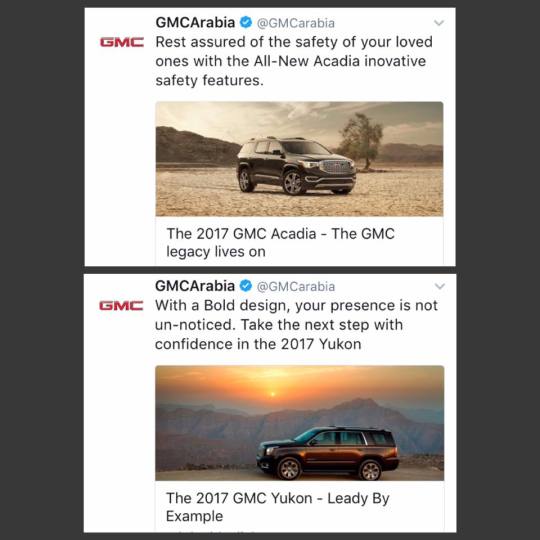
“Rest assured of” and “inovative” are basic grammar and spelling mistakes (change to ‘rest assured that’ and ‘innovative’ with a double n).
With the GMC, a double negative leads to utter confusion along with the chance to “Leady By Example”. Who’s writing this stuff? A 5 year old?
I did message them on twitter and they responded that they amended it.
Things get even better when one actually engages and is taken to a landing page of sorts, where the prospect is supposed to register for a test drive:
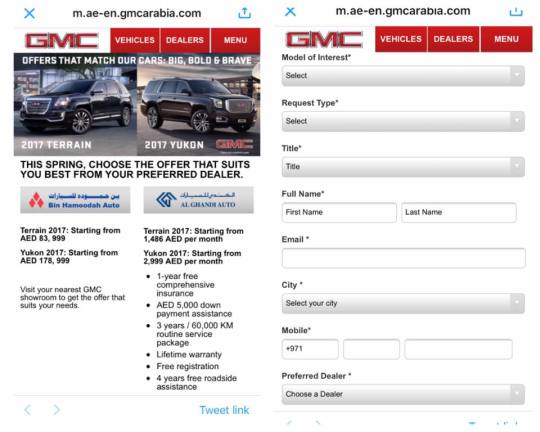
On the left, we see the first landing page, after your selection you are taken to the never ending form on the right.
For mobile users, less is more. Having one car fill up the width of the mobile browser and allowing a thumb scroll interaction would be better than presenting both options at once.
The inconsistent use of font size, emboldening and poor distributor logos all detract from what ostensibly is a premium vehicle.
Moving onto the form itself, it’s a textbook case of designing for inputs to the brand CRM / ERP system, not for the user. If you’re interrupting people on a dynamic social network, (and even if not), best practice for forms dictates 3 fields or 4 at the maximum.
Next up on Twitter ads, the Property sector:

Once again, the “leave no white space unfilled” theory is in full effect. You didn’t actually want to enjoy a full width view of the promoted apartment did you? I’ll just leave that there.
Now let’s see how Lulu tackles Twitter with a new approach, one I like to call, “SuspenseTech”

What are these magical products for these low low prices? You’ve got my attention, but for all the wrong reasons. TELL MEEEEEEE
The body copy of the tweet did include a url so I duly clicked and…..
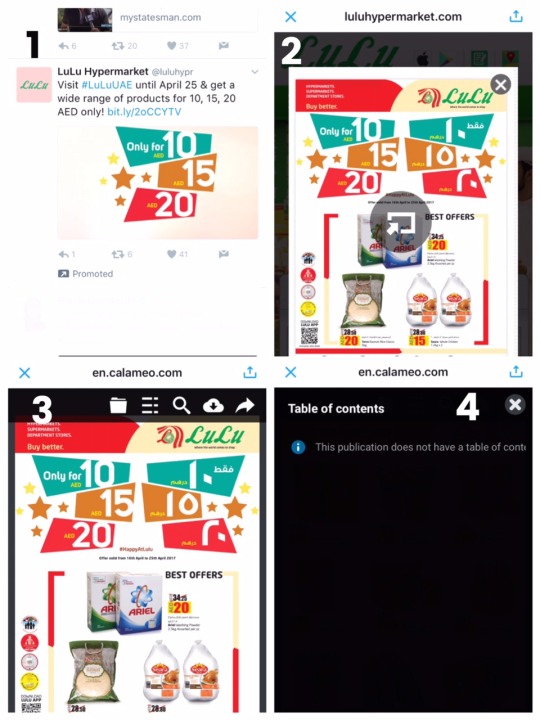
Yes, you’re seeing it correctly. It’s an online brochure. One un-clickable image. With the requirement to click something in the middle or, the X in the corner first.
But wait, something in the main menu looks like it might have more info, unfortunately, the table of contents did not have… a table of contents.
So I’ll be forced to schlep down to the store, wherever that is….
Calameo by the way is just like Issuu. For people who want to replicate the page turning experience online.
Like so
Did you spot the 1st edition of #NationTowers @myconciergeUAE magazine yet? A must for all luxury products & unique experiences #inabudhabi! pic.twitter.com/66a2Gp6M3v
I haven’t found a Twitch channel yet which gives me access to live page turning but i’m sure the good folks at Lulu can oblige.
In some cases, promoted tweets did not resolve to a landing page at all.
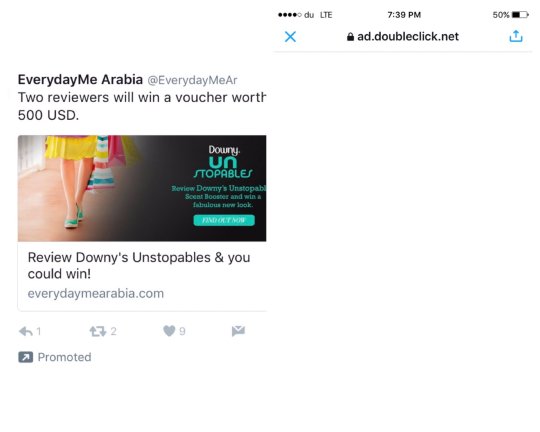
I was also about to go bananas at yet another spelling error (shouldn’t it be “Unstoppables”?) but it turns out it is actually the name of the product. Forget fake news, P&G are promoting fake spelling:
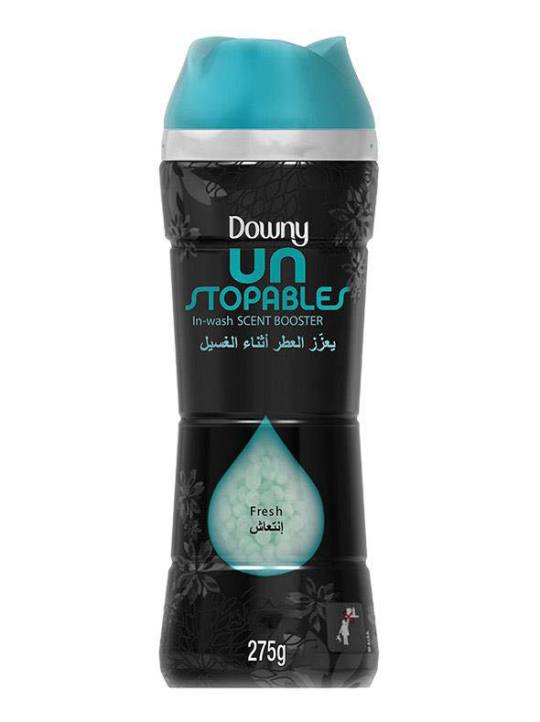
Finally, the Lenovo pad, whose english copy text makes it sound like…..a pad

INSTAGRAM
On Instagram, things aren’t much better, with the main errors being too much copy text which renders the design unreadable, or, for those ‘grams that link out to a browser, the user is led to a non mobile optimized final destination.
For the purposes of brevity, I’ll just show one example, that of twofour54:
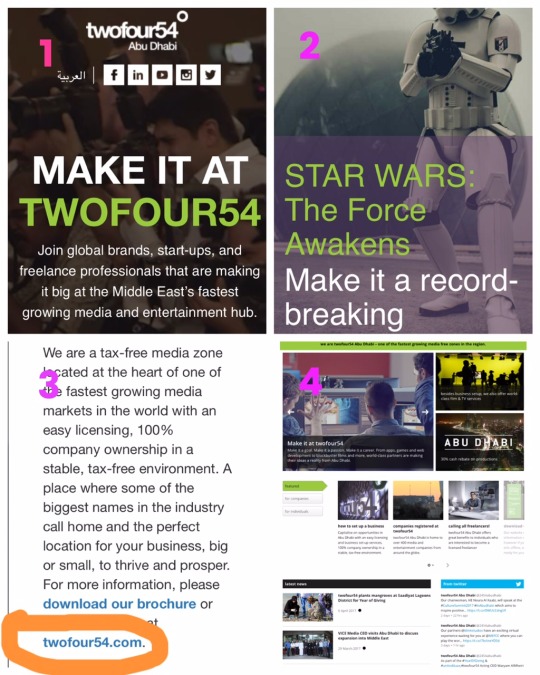
Whilst you do have to wade through rather a lot of content before you get the information that you require, at least it is optimized for mobile viewing. Obviously I’m not going to be downloading a brochure on my phone so I click the url to take me to the money page, where I will hopefully get detailed answers as per my buyer persona, and twofour can get me to hand over my details for their database.
It was all going so well, until I clicked out, and then everything just made my eyes hurt. Additionally, not taking me to an inside page meant I had to start the journey all over again and with that tiny font, I didn’t know where to start.
FACEBOOK
Hopping over to Facebook, Panasonic has clearly spent all its money on the hardware with none left over for decent graphic designers, or web designers for that matter. Take a look:
Husband comes home to find wife behind alien force field. Armed only with his briefcase, how will he reach her?

Alien force field secretly permeates dining room whilst you’re out at work all day.

And the most terrifying of all:
Alien spores trap family in unending spiral of doom.
(also its “breathe” not “breath” - sadly aliens can’t be defeated by poor spelling)

Haunted by the big blue blanket, I click on the required URL to see what else Panasonic has up their sleeve.
The CS-C24TKF could be Klingon for ‘commence countdown’. Looks like a jet engine in the background.

Notice that bit of text peeking out on the right? That’s how it appears in the mobile screen. You can actually scroll on the horizontal plane as well as the vertical plane. This is way too confusing and the user experience suffers as a result.
So far, I understand nothing.
Scrolling further, and the copy text is about as engaging as a plumbing manual. Also, this text-in-banner image simply doesn’t work on mobile. Everything is still way too small. If these are the most important marketable features of the product, why aren’t they more visible?

WAIT A SECOND! The blasted blue blanket of bewilderment is back and now it has green friends which are clearly preventing the woman from getting off the couch......

No review of regional creative would be complete without the old; “stick the product next to a sand dune, and the Middle Easterners will know its for them”.
Take note of the dual colors. Not sure if this means it’s blowing out 55 degree air or it counters it. Help!
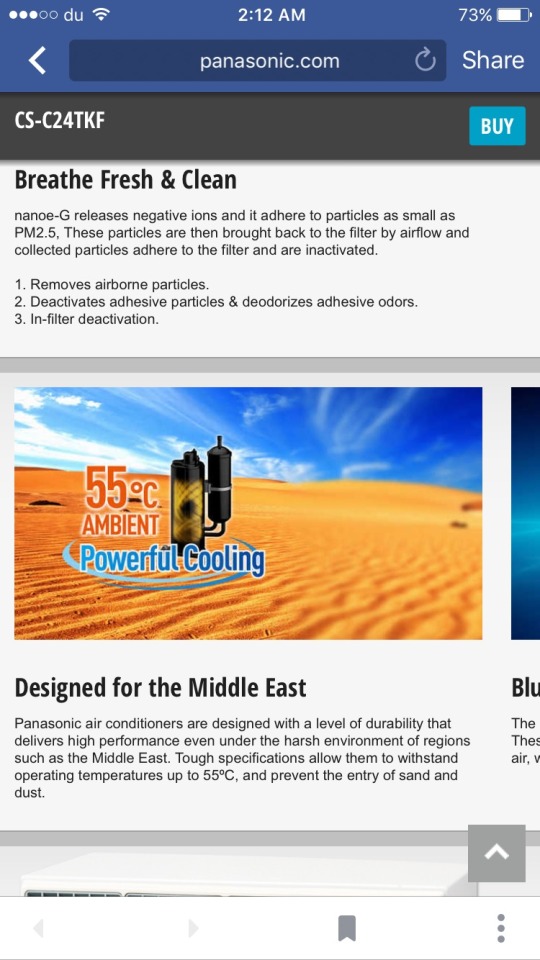
This image tells me nothing. It could be a water flask for my desert hiking trips for all I know. Why is it so hard just to get some decent images and write copy that converts. One minute alien forces are coming out my ac, next i’m stranded in the desert with this weird contraption.
Nevertheless I persist and try to navigate to buying (although I know full well this isn’t an ecommerce site).
First, if i’m online, why not default to “online showrooms”?
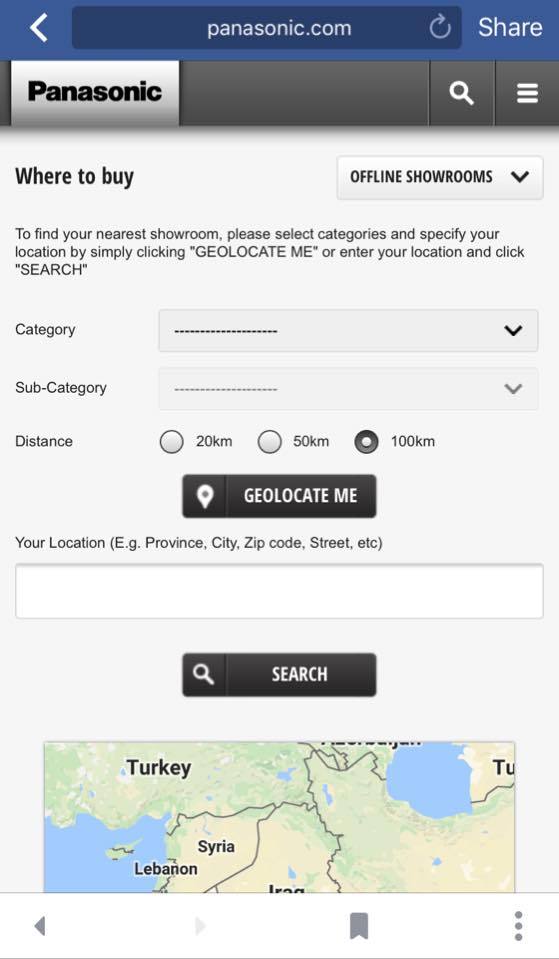
Second, just no. Its WAY too complicated to go through all the instructions. I do not want your product that badly that I need a PHD in form filling to get round your awful geolocation.
How do I know what category? What’s a sub category? What happened to our CS-C24TKF? Why didn’t you tell me what category it was in?
This is another case of repurposing content with no regard for the medium or the user. This looks like a trade marketing brochure. It certainly isn’t as engaging and easy to interact with as most B2C brands. The stock imagery gives it an outdated feel. There is no consideration to a purchase funnel here. The user is left alone to try and navigate a horizontal and vertical scrolling site, with multiple “brand names” (Jet stream, Econavi, Panasonic) and has no idea where to go or what to do.
The best Panasonic can hope for in the absence of investing in their digital channels is the dreaded “post a comment to win” type of social interaction. Which will inevitably be followed with the ubiquitous “interested please review my profile” comment, by the carefully uncurated audience, cultivated as a result of not investing in great web design and copy that converts.
B2B audiences fare no better, with Thomson Reuters dipping its toe in the SME arena. This is a data capture exercise which is most likely being used to add to the excellent and comprehensive Zawya Company Profiles database (Reuters acquired Zawya earlier), however, the on-boarding suffers from poor mobile optimization.
First I followed the journey from the Facebook ad:

I was taken to the landing page, within the Facebook container:

Nice large CTA at the top, but the rest of the space is taken up by waffle. On mobile and particularly as a result of a paid ad, users need a bold statement, a problem that they need a solution to. This will stimulate them to continue the journey.
In addition, use of an animated header similar to Bloomberg or Backchannel would have drawn the user in

(image by Zack Grosser from Aaron Zamost post on Backchannel)
Here’s how a Bloomberg page with animation opens on mobile (video in portrait as most people will be reading this on mobile)
vimeo
bloomberg movie from alex t on Vimeo
Now obviously I’m not suggesting that Reuters throw animated lipsticks all over the landing page, but the point is that a B2B audience deserves some nice front end and it would stand out amongst competitors.
Scrolling down…
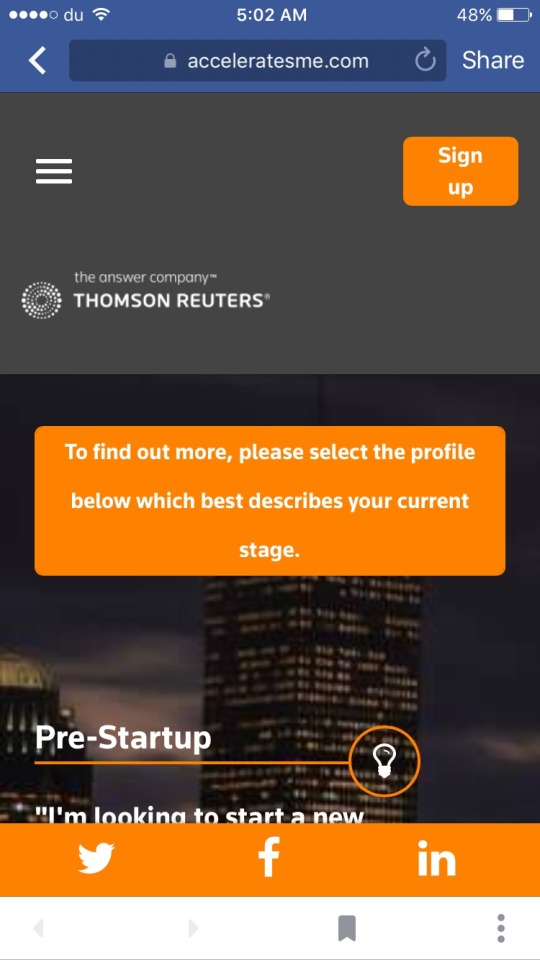
All of a sudden the header appears to have doubled in size, taking up almost half the screen. Why? And, i’m now forced to go through the rigmarole of a signup, which experience tells me will likely be painful, without any reassurance on what I will get if I do so.
I carry on browsing and...

We have entered “lasagna design” territory - piling everything on top of each other. Not a great UX.
I also saw the same ad on Instagram so I followed from there and was taken to the same site but directly in the browser. Much of the same ensued.
Below is part of the form where you register your company:

Pre-populating a form field can be super useful for users, but unless it deploys quickly and is optimized for the mobile screen (above you can see how part of the company name doesn’t fit in the window) it’s frustrating for users and often easier for them to type it in themselves.
The leaders in search tools are Algolia. Using their design and technology, users can get faster access to the information they need.
(As at the time of writing, the acceleratesme.com site is down for maintenance so it’s possible they are working on these issues)
Part 2. Publishers and Display ad journeys
Much has been made in international marketing circles about brand ads appearing next to offensive content on social networks and youtube. Sleeping Giants has been doing a great job of actively trying to pressure brands to pull ads from hateful news sites including Breitbart.com
This is how users report the brands that advertise to the Sleeping Giants account:
@Hertz I'm a loyal Platinum customer. So disappointed to find you advertising on Breitbart, not the best brand fit. @slpng_giants pic.twitter.com/aVW9eJyOyz
Thanks to the joy of programmatic (I assume) we managed to see a few homegrown brands appear on this particular publisher:

The brands are:
Dubai Shopping Festival
Dalma Mall
Rasasi
The Galleria
Rite Bite
Friends Provident International Middle East
I tweeted at them at the time when these appeared, but none of them responded.
As of today, Fulfilme.com, an online grocery store backed by NMC is advertising (desktop site)

Regional publishers more often than not, have not optimized for mobile. This is especially worrisome as the majority of titles are franchised from the mature markets and the parent title has obviously followed best practice. Why doesn’t the franchisee follow suit?
Below, 2 titles from the Motivate Publisher, Campaign Middle East, Cyclist Middle East:
Campaign UK (left) and Campaign Middle East (right):
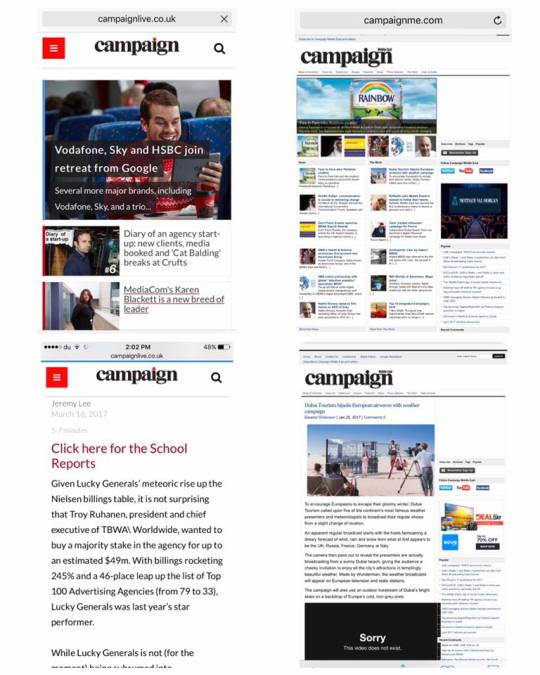
Here is the comparison of Cyclist UK (left) and Cyclist Middle East (right)

There’s a reason I picked this publisher. Campaign Middle East is a B2B magazine for the advertising and communication industry. It frequently reports on digital topics, with contributors noting on many occasions the proliferation of content consumption on mobile. It is therefore absurd that a publisher that talks to companies in this domain doesn’t have a mobile optimized site.
Leaving Thousands of Ad Revenue dollars on the table
This also leaves thousands of potential ad dollars on the table. Much of the growth in Campaign website traffic has been driven by referrals from social channels. As we already know, social is largely consumed on mobile. If Campaign Middle East were to develop a strong mobile presence, and associated ad space, hundreds more clients from the suppliers in digital technology, design and marketing would populate the space with their ads.
Using a CPC model, and potentially combined with an affiliate model, Campaign could grow its sales revenue efficiently whilst clients clearly get value for money.
Some publishers make no secret of their business model. ElleArabia.com has an excessive amount of ads placed next to a tiny amount of content:
Publisher: We need ads to support our content
Brand: Or is it the other way around….?



These Dior ads which appear to be on every female focused lifestyle digital property at the moment, resolve to the international site, dior.com. Ideally you’d send your local traffic to a local landing page. More on that in a later post.
More display horror from the property sector again, this time from Damac:
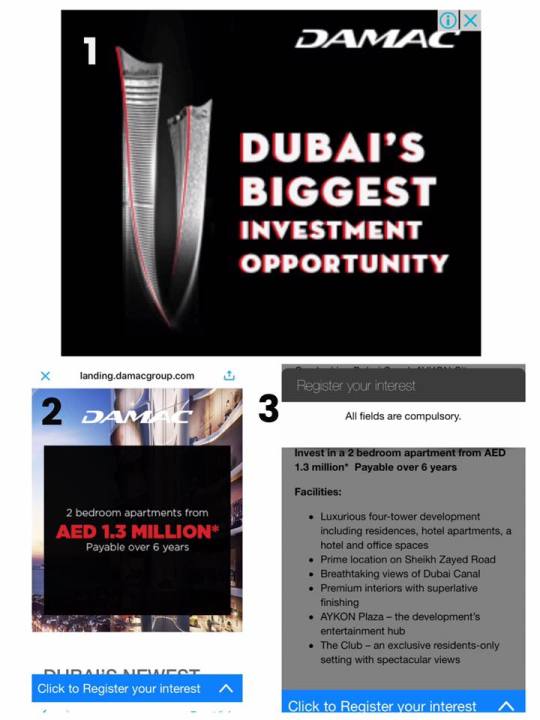
Shadows on the font for an online ad? Headache inducing.
The landing page is ok, although cutting off the sentence near the bottom of the frame makes me nervous that the rest of the mobile experience will be weak.
Unlike others in the space who utilize excessively long form fields, when I clicked to register my interest, there was no form at all.
Money is being left on the table. Again.
Part 3: Emailers
I’ll use the experience of my bank. Financial services firms are notorious for terrible design, even those who push mobile banking in their promotional campaigns appear to forget that their BTL comms needs to be mobile optimized as well.
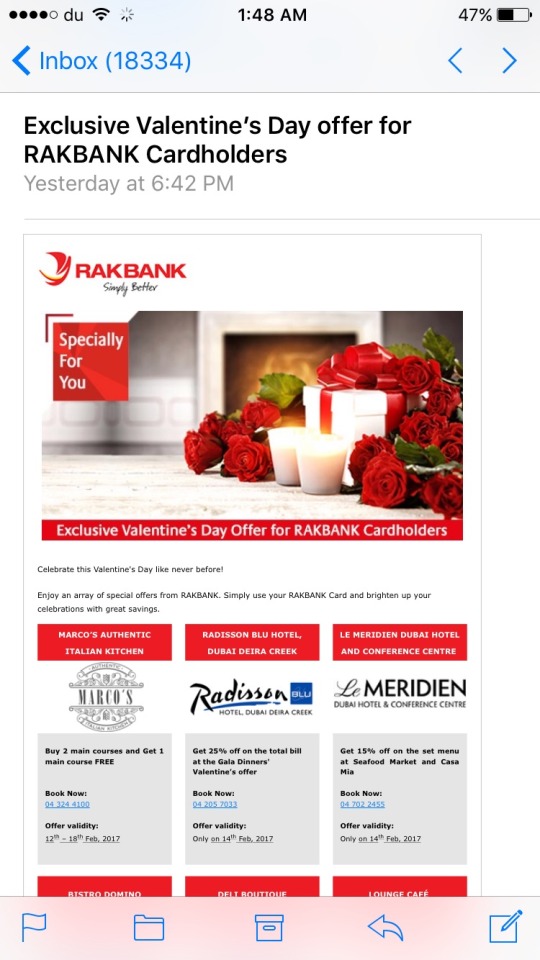
As you can see, this email is being read in my mobile device. The readable parts are the subject line thanks to Apple. You can now compare the unreadability of the rest of the text. There appear to be great offers in here but I can’t read them without zooming.
With a tri-column design, this should be collapsed in the mobile view, for a single column approach. With this tiny font, my fat thumb may misclick.
It turns out there is an entire table of offers in the email. So I scroll and zoom:

The minute I see the word “avail” i’m already put off (see analysis section for more on this).
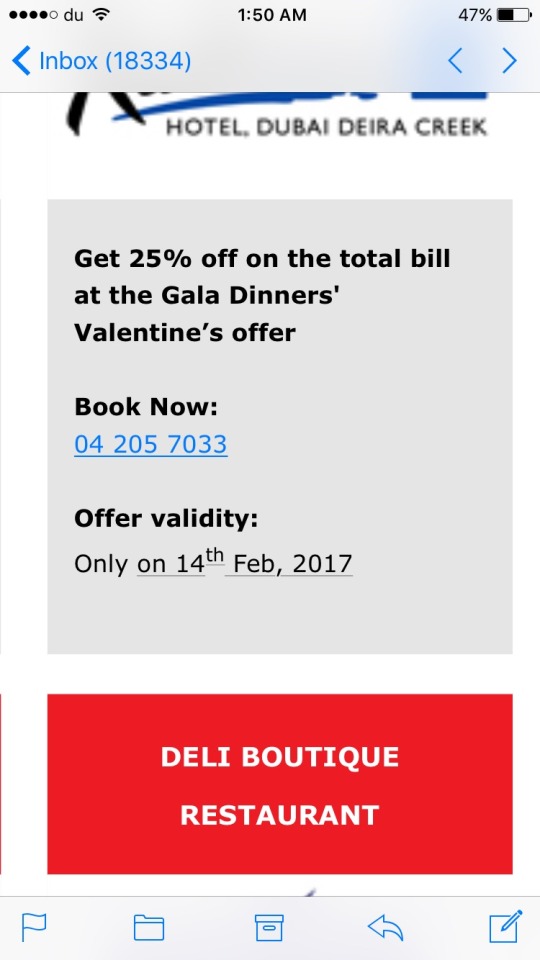
Have you noticed there is no clear CTA in each of the offers? I’m not sure what part I should click and if it will take me to the specific offer. Or how to redeem this offer. So much information packed into this mail, except what I, as the user should do.
Clicking on an offer takes me to…..

Oh great, i’m at another non mobile optimized screen and I didn’t land on the specific offer I clicked. Why? Why do i have to go through the entire journey again? How can I easily find the offer I wanted?
And what about that menu? My fat finger cannot distinctly click on one of those black options.
Co-marketing with banks and offer redemption is a great way to reach a targeted user base, but instead of optimizing for customer journeys, banks leave us to wander in the wilderness, most likely dropping out of the entire funnel. Which means poor redemption rates.
Banks make money when I use my card, so it’s really in their interest to design a journey so I will buy buy buy. I can’t do anything with this.
Here’s another emailer I received. In 2017:

I’ll conclude the design part of this post by two of the most baffling online ads I’ve seen this year:
Mashreq: we don’t like pronouns

And this: Secret Yoghurt hiding in Crisp Packet:

Analysis
All advertisers seek to engage users. Engagement comes from design and, on digital channels, by usability. Of course it can be argued that many brands seek only awareness, rather than to complete the entire journey from awareness to purchase. However, since digital is the only channel that offers the chance to do this, there is no reason why more brands cannot drive to checkout. This offers immediate ROI on your marketing spend.
Nevertheless, if the call to action on social channels is to “Learn More” or click on a link, you need to make sure that
a) the content is there
b) it is designed for mobile and
c) you don’t waste users time.
By shifting the focus back to creative agencies, you ensure that the quality of your brand does not suffer. Creative agencies have user delight at their core, media agencies are more concerned with reach and margins. Brands that do pay more attention to design can easily win here.
Let’s look at a one hypothetical example of a brand that seeks to drive awareness through paid ads on social channels:
Get the users attention in a busy timeline
Getting the users attention in a busy timeline is priority number one. This can be done by great graphics, well produced videos and perfect copytext. But don’t repeat the same creative. Users will become immune. Media agencies who do not frequency cap ads are the bane of consumers lives. Make sure you have a varied portfolio
Have a great reason to pull them out of the social environment
The next step. If you are asking users to link away from a social channel where they want to be spending most of their time, there has to be something riveting for them to do. Riveting for consumers does not usually involve filling out forms. With a varied portfolio of ads, it will be easy to measure which ones consumers are most interested in. Users will click on something to find out more information, here they are in the consideration stage. If there isn’t a huge amount more info to give them - then default to delighting them with design. Everyone will spend time with beautifully crafted design and text. If you don’t have access to great front end designers, use excellent witty copywriters.
Stick to the funnel and try to move to email
If you have managed to successfully complete this step, and you need to continue conversing with the customer to eventually shepherd them to a purchase offline (and on their own terms), then retarget them (with a different creative) on other channels, this time offering them something of value in order for them to leave you their contact details. Emails are the channel that actually result in the best ROI. But you only want to be emailing those that are far enough down the purchase funnel in order to keep conversion rates high and your database relatively clean. Again, make sure your emails are mobile optimized and use the latest design techniques.
Double check its actually mobile optimized
When designing for mobile, about 70% of brands believe that having the content fit in a mobile screen is equal to it being mobile optimized. If your senior executives cannot read all of the content or somebody has to pinch and zoom, then it’s not mobile optimized.
The ROI of Great Design
Essentially you get what you pay for with design. If you choose to spend as little as possible on creative, you will get the corresponding low quality user base. This is acutely true in emerging markets. If you’re a brand reading this you’ll most likely be suffering from a deluge of job related requests on your social channels rather than those that are high quality users, engaged in a conversation and likely to purchase. Because you spent all your money on buying the ad space and nothing on the creative to fill it.
Once again, it can reasonably be argued that the overall quality of audience in this region is low compared to other territories, why spend more when you can spend less. However, we have a wildly heterogeneous audience in the UAE (compared to other GCC markets). Higher quality users are attracted by proper copy using the right syntax and spelling, and excellent design.
By not catering to these users you are leaving money on the table. These users respond to better quality design and tend to be those that will have a higher LTV and higher retention rates.
Obviously this reduces your cost for acquiring customers, which means more money in the bank for you.
Finally, and I cannot stress this enough, investing in great design and UX at the beginning, massively reduces the amount you will spend on support afterwards. A known expenditure for design is much more preferable than an unknown expenditure on community management and engagement and call centres who you may be paying for by the hour.
Advertising online is largely a self serve method. You no longer have to go through an intermediary (ie a media agency) to get access to the space. It is cheaper to either hire or train media buying staff in house than it is to outsource to a media buying agency. If you keep media buying in house you are already saving 10 - 15% of your media buy costs (this percentage would be charged by the agency).
In addition, you get greater transparency on where your media is being spent. By spending less on media and investing more in design and creative, the results will allow a quicker ROI and the time spent to recoup that investment will be shorter. And, great design is the cornerstone of competitive advertising strategies.
When outsourcing digital design you’ll need to look for the following roles:
Graphic Design
Front End Design
UX and UI Design
Copywriters (ideally not bilingual, get one for each language you operate in)
Email Design
Mobile Design
Focus on delighting users, wowing them with creativity and usability and making it as easy as possible for them to accomplish whatever task is required.
0 notes
Text
Jay Acunzo on How to be an Exceptional Marketer
Do something different, they say. Be bold. Stand out from the pack! The list of clichéd instructions on how to improve just about anything according to them is, well, endless. So, when all the “expert” advice becomes white noise, we might as well render it meaningless. If we’re all following the same guidance, aren’t we all a bunch of followers?
Instead, marketing and sales pros must dig deeper to uncover what can truly set initiatives apart. And no, these won’t come from yet another blog.
What differentiates best practices from the right practices comes down to what Jay Acunzo, an award-winning podcaster, and dynamic speaker, says is not much more than your intuition. As the former digital media strategist at Google and head of content marketing at HubSpot, he knows a thing or two about what it takes to be the difference. I interviewed Jay to find out what marketers can do to break away from banality in a way that really matters to themselves and their customers.
Q: You’ve been quoted as saying, “It has never been easier to be average.” Expand on how this applies to today’s digital marketing landscape. How do we prevent mediocrity from creeping into the creative output?
Think about the amount of information you have access to and the speed at which you can access it. It has never been easier to find and follow someone else’s idea or answer. You need direction and someone else has pretty much handed you a “how-to.” Done. Simple.
Unfortunately, generalized advice is the best these so-called expert opinions can provide—without knowing your context, who you are, who your team is, who your customers are, etc. You can’t remove an individual from the situation, and because experts make their living providing broadly applicable knowledge, you’re just defaulting to whatever latest trend they report. You’re doing commodity work.
With more and more experts coming out of the woodwork, it’s never been easier to be average. So, the question is, what does it take to be exceptional in a world where average is now table stakes?
Q: But how can marketers initiate acting on something differently? How do we acquire the confidence to push back on the status quo?
Those doing the work have to unleash their full potential. Stop obsessing over some guru’s answers, and start asking yourself the right questions. Then almost naturally, you’ll start to focus less on generalized advice and more on the specifics of your own context, as well as the abilities of your aspirations.
Q: You host the Unthinkable podcast. What’s been your favorite strategy or guest story? What lessons can we pull about standing out in increasingly noisy digital ecosystems?
We’ve had so many incredible guests, from Disney to TED speakers to best-selling authors. But one of my all-time favorite stories involved Lisa Schneider, Chief Digital Officer at dictionary publisher Merriam-Webster. You’d never expect someone from Merriam-Webster—a brand not known to be particularly exciting—to engage in this crazy, imaginative work. But they’ve differentiated so successfully due to readjusting their focus on their team and audience, ignoring industry precedents and current digital marketing trends.
Merriam-Webster had an ordinary, corporate Twitter account that posted similar stuff and automated the same old thing, daily. Until one day, Lisa checked out the company’s internal chat groups and noticed how lively, fun, smart, and witty they were. She realized if we acted like our true selves in public, more people might enjoy what we have to offer. Fast forward to today: Merriam-Webster has over 550,000 Twitter followers and received around 7,000% more press this year than last year.
Q: What channels offer marketers the most opportunity to stand out?
Look, if somebody on a blog post tells you that a certain channel or tactic is the answer and you follow it, you’re doing commodity work. Because that expert doesn’t know your context. Unless you focus on your team’s abilities, your brand’s aspirations, and your customer’s ongoing experiences, it’s virtually impossible to apply generic answers from a blog post and succeed at a rate that’s anything but average.
Because you have so many channels, you’re all looking for a single answer. Instead, you should celebrate all possibilities. The digital age bestows us with countless options to vet for our own situations.
Ask yourself:
Which of these possibilities match my team and the way I speak to the world when I’m not a marketer?
What is it about ME that’s different?
What do I bring to the table?
Which of these channels can best amplify my unique attributes?
Q: Let’s talk automation. We can’t live without it. How can we use automation to better our marketing and creativity?
Effective automation can be indispensable—if it’s not put on repeat. You start by asking questions, you find an answer, and then you funnel the answer through automation so it continues to spit out the same answer. This can be powerful, but only if you regularly revisit the answer and make sure it applies to new scenarios.
Successful marketers must own their problems, questions, and audience insights. Automation is a fast track to complacency unless you commit to asking the right questions of various human sources and continuously update your technology.
Q: We know a big tenet of yours is trusting intuition and not settling for mediocre work. What’s more important—the message or the methodology of how it’s spread?
Intuition is often misinterpreted as being the muse that gives you the answer. In reality, the Latin root means knowledge from within or an ongoing process of thinking for yourself. So, if you’re just pumping out copy, good things won’t happen. However, if you truly understand and articulate the process and seriously consider the “why,” you create a kink in the curve and start improving exponentially.
If you look to achieve a goal by relying on how people reached it in the past, you contribute to conventional thinking. Instead, add your own questions and consider all the different ways you could accomplish your goal. Treat gurus as just one source for identifying all possibilities. Remember, the key is to question and test everything.
Want to learn more about becoming exceptional in the world of marketing? Check out Jay Acunzo at ZoomInfo’s 2017 Growth Acceleration Summit on Sept. 13-14 in Boston where we’ll be covering best practices, growth strategies, and the future of data.
Do you have an example of exceptional marketing? I’d love to hear your example in the comments below.
The post Jay Acunzo on How to be an Exceptional Marketer appeared first on Marketo Marketing Blog - Best Practices and Thought Leadership.
from http://blog.marketo.com/2017/07/jay-acunzo-exceptional-marketer.html
0 notes
Text
Jay Acunzo on How to be an Exceptional Marketer
Do something different, they say. Be bold. Stand out from the pack! The list of clichéd instructions on how to improve just about anything according to them is, well, endless. So, when all the “expert” advice becomes white noise, we might as well render it meaningless. If we’re all following the same guidance, aren’t we all a bunch of followers?
Instead, marketing and sales pros must dig deeper to uncover what can truly set initiatives apart. And no, these won’t come from yet another blog.
What differentiates best practices from the right practices comes down to what Jay Acunzo, an award-winning podcaster, and dynamic speaker, says is not much more than your intuition. As the former digital media strategist at Google and head of content marketing at HubSpot, he knows a thing or two about what it takes to be the difference. I interviewed Jay to find out what marketers can do to break away from banality in a way that really matters to themselves and their customers.
Q: You’ve been quoted as saying, “It has never been easier to be average.” Expand on how this applies to today’s digital marketing landscape. How do we prevent mediocrity from creeping into the creative output?
Think about the amount of information you have access to and the speed at which you can access it. It has never been easier to find and follow someone else’s idea or answer. You need direction and someone else has pretty much handed you a “how-to.” Done. Simple.
Unfortunately, generalized advice is the best these so-called expert opinions can provide—without knowing your context, who you are, who your team is, who your customers are, etc. You can’t remove an individual from the situation, and because experts make their living providing broadly applicable knowledge, you’re just defaulting to whatever latest trend they report. You’re doing commodity work.
With more and more experts coming out of the woodwork, it’s never been easier to be average. So, the question is, what does it take to be exceptional in a world where average is now table stakes?
Q: But how can marketers initiate acting on something differently? How do we acquire the confidence to push back on the status quo?
Those doing the work have to unleash their full potential. Stop obsessing over some guru’s answers, and start asking yourself the right questions. Then almost naturally, you’ll start to focus less on generalized advice and more on the specifics of your own context, as well as the abilities of your aspirations.
Q: You host the Unthinkable podcast. What’s been your favorite strategy or guest story? What lessons can we pull about standing out in increasingly noisy digital ecosystems?
We’ve had so many incredible guests, from Disney to TED speakers to best-selling authors. But one of my all-time favorite stories involved Lisa Schneider, Chief Digital Officer at dictionary publisher Merriam-Webster. You’d never expect someone from Merriam-Webster—a brand not known to be particularly exciting—to engage in this crazy, imaginative work. But they’ve differentiated so successfully due to readjusting their focus on their team and audience, ignoring industry precedents and current digital marketing trends.
Merriam-Webster had an ordinary, corporate Twitter account that posted similar stuff and automated the same old thing, daily. Until one day, Lisa checked out the company’s internal chat groups and noticed how lively, fun, smart, and witty they were. She realized if we acted like our true selves in public, more people might enjoy what we have to offer. Fast forward to today: Merriam-Webster has over 550,000 Twitter followers and received around 7,000% more press this year than last year.
Q: What channels offer marketers the most opportunity to stand out?
Look, if somebody on a blog post tells you that a certain channel or tactic is the answer and you follow it, you’re doing commodity work. Because that expert doesn’t know your context. Unless you focus on your team’s abilities, your brand’s aspirations, and your customer’s ongoing experiences, it’s virtually impossible to apply generic answers from a blog post and succeed at a rate that’s anything but average.
Because you have so many channels, you’re all looking for a single answer. Instead, you should celebrate all possibilities. The digital age bestows us with countless options to vet for our own situations.
Ask yourself:
Which of these possibilities match my team and the way I speak to the world when I’m not a marketer?
What is it about ME that’s different?
What do I bring to the table?
Which of these channels can best amplify my unique attributes?
Q: Let’s talk automation. We can’t live without it. How can we use automation to better our marketing and creativity?
Effective automation can be indispensable—if it’s not put on repeat. You start by asking questions, you find an answer, and then you funnel the answer through automation so it continues to spit out the same answer. This can be powerful, but only if you regularly revisit the answer and make sure it applies to new scenarios.
Successful marketers must own their problems, questions, and audience insights. Automation is a fast track to complacency unless you commit to asking the right questions of various human sources and continuously update your technology.
Q: We know a big tenet of yours is trusting intuition and not settling for mediocre work. What’s more important—the message or the methodology of how it’s spread?
Intuition is often misinterpreted as being the muse that gives you the answer. In reality, the Latin root means knowledge from within or an ongoing process of thinking for yourself. So, if you’re just pumping out copy, good things won’t happen. However, if you truly understand and articulate the process and seriously consider the “why,” you create a kink in the curve and start improving exponentially.
If you look to achieve a goal by relying on how people reached it in the past, you contribute to conventional thinking. Instead, add your own questions and consider all the different ways you could accomplish your goal. Treat gurus as just one source for identifying all possibilities. Remember, the key is to question and test everything.
Want to learn more about becoming exceptional in the world of marketing? Check out Jay Acunzo at ZoomInfo’s 2017 Growth Acceleration Summit on Sept. 13-14 in Boston where we’ll be covering best practices, growth strategies, and the future of data.
Do you have an example of exceptional marketing? I’d love to hear your example in the comments below.
The post Jay Acunzo on How to be an Exceptional Marketer appeared first on Marketo Marketing Blog - Best Practices and Thought Leadership.
from http://blog.marketo.com/2017/07/jay-acunzo-exceptional-marketer.html
0 notes
Text
Jay Acunzo on How to be an Exceptional Marketer
Do something different, they say. Be bold. Stand out from the pack! The list of clichéd instructions on how to improve just about anything according to them is, well, endless. So, when all the “expert” advice becomes white noise, we might as well render it meaningless. If we’re all following the same guidance, aren’t we all a bunch of followers?
Instead, marketing and sales pros must dig deeper to uncover what can truly set initiatives apart. And no, these won’t come from yet another blog.
What differentiates best practices from the right practices comes down to what Jay Acunzo, an award-winning podcaster, and dynamic speaker, says is not much more than your intuition. As the former digital media strategist at Google and head of content marketing at HubSpot, he knows a thing or two about what it takes to be the difference. I interviewed Jay to find out what marketers can do to break away from banality in a way that really matters to themselves and their customers.
Q: You’ve been quoted as saying, “It has never been easier to be average.” Expand on how this applies to today’s digital marketing landscape. How do we prevent mediocrity from creeping into the creative output?
Think about the amount of information you have access to and the speed at which you can access it. It has never been easier to find and follow someone else’s idea or answer. You need direction and someone else has pretty much handed you a “how-to.” Done. Simple.
Unfortunately, generalized advice is the best these so-called expert opinions can provide—without knowing your context, who you are, who your team is, who your customers are, etc. You can’t remove an individual from the situation, and because experts make their living providing broadly applicable knowledge, you’re just defaulting to whatever latest trend they report. You’re doing commodity work.
With more and more experts coming out of the woodwork, it’s never been easier to be average. So, the question is, what does it take to be exceptional in a world where average is now table stakes?
Q: But how can marketers initiate acting on something differently? How do we acquire the confidence to push back on the status quo?
Those doing the work have to unleash their full potential. Stop obsessing over some guru’s answers, and start asking yourself the right questions. Then almost naturally, you’ll start to focus less on generalized advice and more on the specifics of your own context, as well as the abilities of your aspirations.
Q: You host the Unthinkable podcast. What’s been your favorite strategy or guest story? What lessons can we pull about standing out in increasingly noisy digital ecosystems?
We’ve had so many incredible guests, from Disney to TED speakers to best-selling authors. But one of my all-time favorite stories involved Lisa Schneider, Chief Digital Officer at dictionary publisher Merriam-Webster. You’d never expect someone from Merriam-Webster—a brand not known to be particularly exciting—to engage in this crazy, imaginative work. But they’ve differentiated so successfully due to readjusting their focus on their team and audience, ignoring industry precedents and current digital marketing trends.
Merriam-Webster had an ordinary, corporate Twitter account that posted similar stuff and automated the same old thing, daily. Until one day, Lisa checked out the company’s internal chat groups and noticed how lively, fun, smart, and witty they were. She realized if we acted like our true selves in public, more people might enjoy what we have to offer. Fast forward to today: Merriam-Webster has over 550,000 Twitter followers and received around 7,000% more press this year than last year.
Q: What channels offer marketers the most opportunity to stand out?
Look, if somebody on a blog post tells you that a certain channel or tactic is the answer and you follow it, you’re doing commodity work. Because that expert doesn’t know your context. Unless you focus on your team’s abilities, your brand’s aspirations, and your customer’s ongoing experiences, it’s virtually impossible to apply generic answers from a blog post and succeed at a rate that’s anything but average.
Because you have so many channels, you’re all looking for a single answer. Instead, you should celebrate all possibilities. The digital age bestows us with countless options to vet for our own situations.
Ask yourself:
Which of these possibilities match my team and the way I speak to the world when I’m not a marketer?
What is it about ME that’s different?
What do I bring to the table?
Which of these channels can best amplify my unique attributes?
Q: Let’s talk automation. We can’t live without it. How can we use automation to better our marketing and creativity?
Effective automation can be indispensable—if it’s not put on repeat. You start by asking questions, you find an answer, and then you funnel the answer through automation so it continues to spit out the same answer. This can be powerful, but only if you regularly revisit the answer and make sure it applies to new scenarios.
Successful marketers must own their problems, questions, and audience insights. Automation is a fast track to complacency unless you commit to asking the right questions of various human sources and continuously update your technology.
Q: We know a big tenet of yours is trusting intuition and not settling for mediocre work. What’s more important—the message or the methodology of how it’s spread?
Intuition is often misinterpreted as being the muse that gives you the answer. In reality, the Latin root means knowledge from within or an ongoing process of thinking for yourself. So, if you’re just pumping out copy, good things won’t happen. However, if you truly understand and articulate the process and seriously consider the “why,” you create a kink in the curve and start improving exponentially.
If you look to achieve a goal by relying on how people reached it in the past, you contribute to conventional thinking. Instead, add your own questions and consider all the different ways you could accomplish your goal. Treat gurus as just one source for identifying all possibilities. Remember, the key is to question and test everything.
Want to learn more about becoming exceptional in the world of marketing? Check out Jay Acunzo at ZoomInfo’s 2017 Growth Acceleration Summit on Sept. 13-14 in Boston where we’ll be covering best practices, growth strategies, and the future of data.
Do you have an example of exceptional marketing? I’d love to hear your example in the comments below.
The post Jay Acunzo on How to be an Exceptional Marketer appeared first on Marketo Marketing Blog - Best Practices and Thought Leadership.
from http://blog.marketo.com/2017/07/jay-acunzo-exceptional-marketer.html
0 notes
Text
Jay Acunzo on How to be an Exceptional Marketer
Do something different, they say. Be bold. Stand out from the pack! The list of clichéd instructions on how to improve just about anything according to them is, well, endless. So, when all the “expert” advice becomes white noise, we might as well render it meaningless. If we’re all following the same guidance, aren’t we all a bunch of followers?
Instead, marketing and sales pros must dig deeper to uncover what can truly set initiatives apart. And no, these won’t come from yet another blog.
What differentiates best practices from the right practices comes down to what Jay Acunzo, an award-winning podcaster, and dynamic speaker, says is not much more than your intuition. As the former digital media strategist at Google and head of content marketing at HubSpot, he knows a thing or two about what it takes to be the difference. I interviewed Jay to find out what marketers can do to break away from banality in a way that really matters to themselves and their customers.
Q: You’ve been quoted as saying, “It has never been easier to be average.” Expand on how this applies to today’s digital marketing landscape. How do we prevent mediocrity from creeping into the creative output?
Think about the amount of information you have access to and the speed at which you can access it. It has never been easier to find and follow someone else’s idea or answer. You need direction and someone else has pretty much handed you a “how-to.” Done. Simple.
Unfortunately, generalized advice is the best these so-called expert opinions can provide—without knowing your context, who you are, who your team is, who your customers are, etc. You can’t remove an individual from the situation, and because experts make their living providing broadly applicable knowledge, you’re just defaulting to whatever latest trend they report. You’re doing commodity work.
With more and more experts coming out of the woodwork, it’s never been easier to be average. So, the question is, what does it take to be exceptional in a world where average is now table stakes?
Q: But how can marketers initiate acting on something differently? How do we acquire the confidence to push back on the status quo?
Those doing the work have to unleash their full potential. Stop obsessing over some guru’s answers, and start asking yourself the right questions. Then almost naturally, you’ll start to focus less on generalized advice and more on the specifics of your own context, as well as the abilities of your aspirations.
Q: You host the Unthinkable podcast. What’s been your favorite strategy or guest story? What lessons can we pull about standing out in increasingly noisy digital ecosystems?
We’ve had so many incredible guests, from Disney to TED speakers to best-selling authors. But one of my all-time favorite stories involved Lisa Schneider, Chief Digital Officer at dictionary publisher Merriam-Webster. You’d never expect someone from Merriam-Webster—a brand not known to be particularly exciting—to engage in this crazy, imaginative work. But they’ve differentiated so successfully due to readjusting their focus on their team and audience, ignoring industry precedents and current digital marketing trends.
Merriam-Webster had an ordinary, corporate Twitter account that posted similar stuff and automated the same old thing, daily. Until one day, Lisa checked out the company’s internal chat groups and noticed how lively, fun, smart, and witty they were. She realized if we acted like our true selves in public, more people might enjoy what we have to offer. Fast forward to today: Merriam-Webster has over 550,000 Twitter followers and received around 7,000% more press this year than last year.
Q: What channels offer marketers the most opportunity to stand out?
Look, if somebody on a blog post tells you that a certain channel or tactic is the answer and you follow it, you’re doing commodity work. Because that expert doesn’t know your context. Unless you focus on your team’s abilities, your brand’s aspirations, and your customer’s ongoing experiences, it’s virtually impossible to apply generic answers from a blog post and succeed at a rate that’s anything but average.
Because you have so many channels, you’re all looking for a single answer. Instead, you should celebrate all possibilities. The digital age bestows us with countless options to vet for our own situations.
Ask yourself:
Which of these possibilities match my team and the way I speak to the world when I’m not a marketer?
What is it about ME that’s different?
What do I bring to the table?
Which of these channels can best amplify my unique attributes?
Q: Let’s talk automation. We can’t live without it. How can we use automation to better our marketing and creativity?
Effective automation can be indispensable—if it’s not put on repeat. You start by asking questions, you find an answer, and then you funnel the answer through automation so it continues to spit out the same answer. This can be powerful, but only if you regularly revisit the answer and make sure it applies to new scenarios.
Successful marketers must own their problems, questions, and audience insights. Automation is a fast track to complacency unless you commit to asking the right questions of various human sources and continuously update your technology.
Q: We know a big tenet of yours is trusting intuition and not settling for mediocre work. What’s more important—the message or the methodology of how it’s spread?
Intuition is often misinterpreted as being the muse that gives you the answer. In reality, the Latin root means knowledge from within or an ongoing process of thinking for yourself. So, if you’re just pumping out copy, good things won’t happen. However, if you truly understand and articulate the process and seriously consider the “why,” you create a kink in the curve and start improving exponentially.
If you look to achieve a goal by relying on how people reached it in the past, you contribute to conventional thinking. Instead, add your own questions and consider all the different ways you could accomplish your goal. Treat gurus as just one source for identifying all possibilities. Remember, the key is to question and test everything.
Want to learn more about becoming exceptional in the world of marketing? Check out Jay Acunzo at ZoomInfo’s 2017 Growth Acceleration Summit on Sept. 13-14 in Boston where we’ll be covering best practices, growth strategies, and the future of data.
Do you have an example of exceptional marketing? I’d love to hear your example in the comments below.
The post Jay Acunzo on How to be an Exceptional Marketer appeared first on Marketo Marketing Blog - Best Practices and Thought Leadership.
from http://blog.marketo.com/2017/07/jay-acunzo-exceptional-marketer.html
0 notes